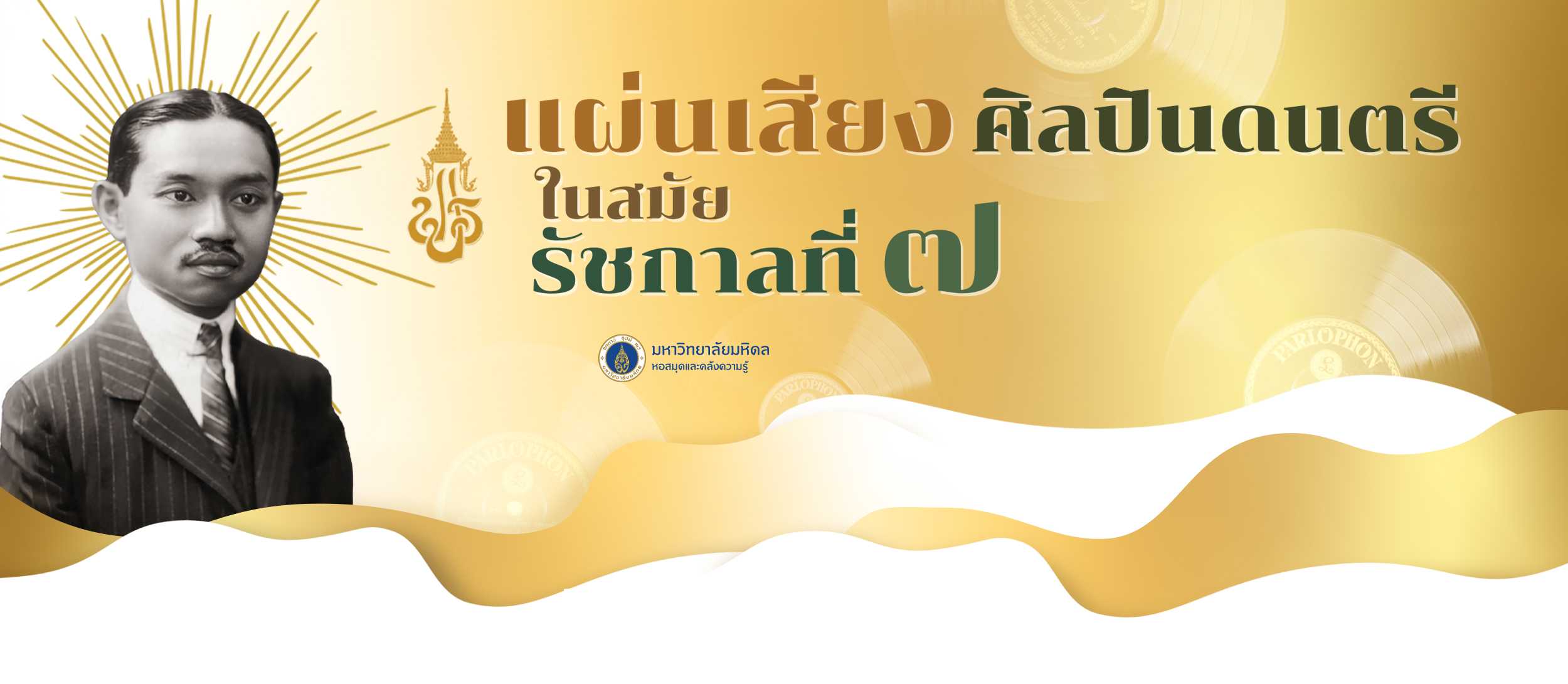

2468
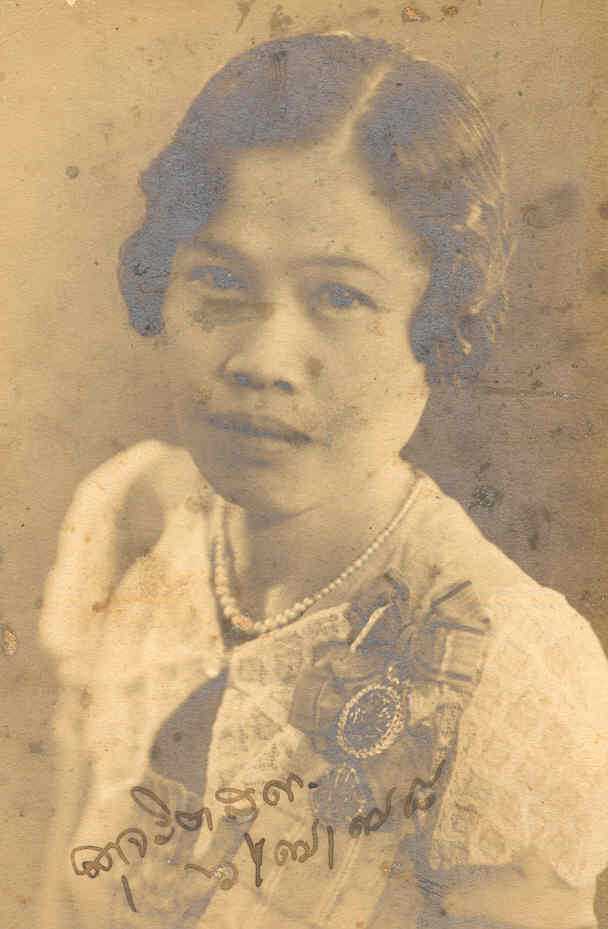
พระสนมเอกในรัชกาลที่ 6 ผู้ก่อตั้งวงดนตรีคณะนารีศรีสุมิตรและผู้จัดทำแผ่นเสียงนารีศรีสุมิตรPhra Sucharit Suda (Prueang Sutcharitakul), the Royal Consort of King Rama VI, was the founder of the Naree Srisumit Ensemble and the producer of the Naree Srisumit record.

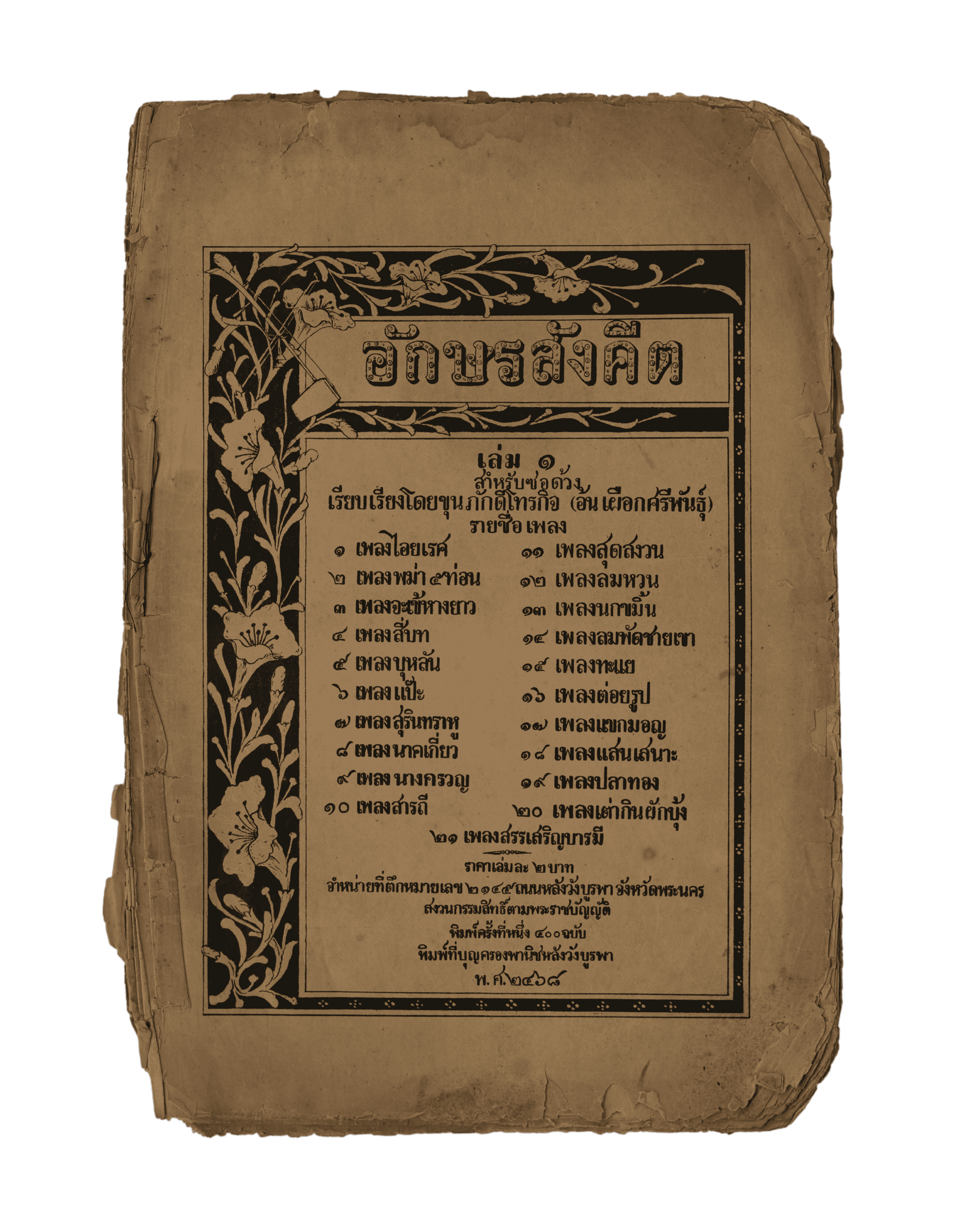
ราว พ.ศ. 2468-2469 พระสุจริตสุดา (เปรื่อง สุจริตกุล) ได้จัดให้มีการบันทึกเสียงวงดนตรีของท่านซึ่งเป็น วงเครื่องสายผสมเปียนโนหญิงล้วน วงแรกของประเทศไทย โดยทำการบันทึกเสียงร่วมกับห้าง ต. เง็กชวน บางลำพู และบริษัทดอยเช่แกรมโมโฟน (Deutsche Grammophon) จากประเทศเยอรมัน หน้าแผ่นเสียงมีสีน้ำเงินและมีตรากรอบพักตร์สีทอง เขียนชื่อว่า "คณะนารีศรีสุมิตร" (พูนพิศ อมาตยกุล, 2526, น. 24-27)
พบการบันทึกโน้ตเพลงอักษรสังคีต สำหรับซอด้วง เรียบเรียงโ�ดยขุนภักดีโทรกิจ (อ้น เผือกศรีพันธุ์) จำนวน 21 เพลง ได้แก่
- 1. เพลงไอยเรศ
- 2. เพลงพม่า 5 ท่อน
- 3. เพลงจะเข้หางยาว
- 4. เพลงสี่บท
- 5. เพลงบุหลัน
- 6. เพลงแป๊ะ
- 7. เพลงสุรินทราหู
- 8. เพลงนาคเกี่ยว
- 9. เพลงนางครวญ
- 10. เพลงสารถี
- 11. เพลงสุดสงวน
- 12. เพลงลมหวน
- 13. เพลงนกขมิ้น
- 14. เพลงลมพัดชายเขา
- 15. เพลงทะแย
- 16. เพลงต่อยรูป
- 17. เพลงแขกมอญ
- 18. เพลงแสนเสนาะ
- 19. เพลงปลาทอง
- 20. เพลงเต่ากินผักบุ้ง
- 21. เพลงสรรเสริญพระบารมี
จำหน่ายที่ตึกหมายเลข 2149 ถนนหลังวังบูรพา พระนคร ราคาเล่มละ 2 บาท พิมพ์ที่บุญครองพานิชหลังวังบูรพา (อัษฎาวุธ สาคริก, การสื่อสารส่วนบุคคล, 4 กุมภาพันธ์ 2568)
A musical score titled Akson Sangkheet for the Saw Duang was found, arranged by Khun Phakdee Tharokit (On Puek Sri Phan), contained 21 songs:
- 1. Ayaret (The Retusa Orchid)
- 2. Burma Ha Thon (Burma five parts)
- 3. Chai Khaeng Yao (The Long Tailed Crocodile)
- 4. Si Bot (Four sections)
- 5. Bulan (The Flowers)
- 6. Pae (The Old Man)
- 7. Surintharahu
- 8. Nak Khieow
- 9. Nang Khruan (The Crying maiden)
- 10. Sarathi (The Coachman)
- 11. Sut Songwan (The Most Precious)
- 12. Lom Huan (The Backing Wind)
- 13. Nok Khamin (The Oriole)
- 14. Lom Phat Chai Khao (Breeze on the foot of the mountain)
- 15. Tha Ya
- 16. Toy Rup
- 17. Khaek Mon
- 18. Saen Sano
- 19. Pla Thong (The Goldfish)
- 20. Tao Kin Phak Bung (Turtle eating water spinach song)
- 21. Sansern Phra Baramee
The score was sold at Building No. 2149, Behind Wang Burapha, Phra Nakhon, for 2 baht per copy, printed by Boonkrong Panit Behind Wang Burapha. (Atsadawut Sagarik, personal communication, February 4, 2025)
2469
พระบาทสมเด็จพระปกเกล้าเจ้าอยู่หัวและสมเด็จพระนางเจ้ารำไพพรรณี พระบรมราชินี เสด็จพระราชดำเนินเลียบมณฑลฝ่ายเหนือและมณฑลพายัพ ระหว่างวันที่ 6 มกราคม ถึง 5 กุมภาพันธ์ พ.ศ. 2469 เมื่อครั้งเสด็จเยี่ยมราษฎรในนครเชียงใหม่ พระราชชายา เจ้าดารารัศมี ได้ทรงจัดการแสดงถวายหลายชุด โดยฟ้อนม่านมุยเชี�ยงตา เป็นการแสดงชุดหนึ่งที่เจ้าดารารัศมีทรงประดิษฐ์ขึ้นใหม่ นอกจากนี้ยังมีระบำซอที่ได้ถูกนำมาบันทึกเสียงที่กรุงเทพฯ ในเวลาต่อมา (พูนพิศ อมาตยกุล, 2540, น. 244-248)
"เจ้าดารารัศมี พระราชชายา" เจ้าหญิงในราชวงศ์ทิพย์จักรจากนครเชียงใหม่ เป็นผู้จัดการแสดงถวายรัชกาลที่ 7 เมื่อครั้งเสด็จพระราชดำเนินเลียบมณฑลพายัพ หนึ่งในนั้นคือการแสดง ระบำซอ ได้ถูกบันทึกแผ่นเสียงที่กรุงเทพมหานครเวลาต่อมา ในชื่อ "เพลงสมโภชพระเสวตร์คชเดชน์ดิลก"
พบหนังสือละคอนพูด คณะสามัคยาจารย์ แสดง ณ วังบูรพาภิรมย์ วันจันทร์ที่ 7 มีนาคม พ.ศ. 2469 เรื่อง "เสียรอย" พระยาโอวาทวรกิจ ผูกเรื่องและแต่ง กับเรื่อง "ละครข้าพเจ้า" พระยาไพศาลศิลปสาตร แปลงจากเรื่อง Between the Acts (อัษฎาวุธ สาคริก, การสื่อสารส่วนบุคคล, 4 กุมภาพันธ์ 2568)
His Majesty King Prajadhipok (Rama VII) and Her Majesty Queen Rambai Barni took a trip through the Northern and Northwestern circle from January 6th to February 5th, 1926. During their visit to the people of Chiang Mai, Her Highness Princess Dara Rasmi organized several performances in their honor, including the Man Mui Chienta Dance, which was invented by the Princess. In addition, the Sow dance was later recorded in Bangkok. (Poonpit Amatyakul, 1997: 244-248)
Her Highness Princess Dara Rasmi, a princess of the Thipchakra royal dynasty from Chiang Mai organized performances in honor of His Majesty King Prajadhipok (Rama VII) during His Majesty's royal visit to the Northwestern circle.
A playbook of a spoken drama performed by the Samakkayajarn troupe at Wang Buraphaphirum on Monday, March 7, 1926, featuring the play "Siaroy" written and composed by sir Phaya Owath Worakit, and the play "Lakhon Khajao" (My Drama) by Phaya Phitsal Silapasatra, adapted from the work Between the Acts. (Asadawut Sakorik, personal communication, February 4, 2025)
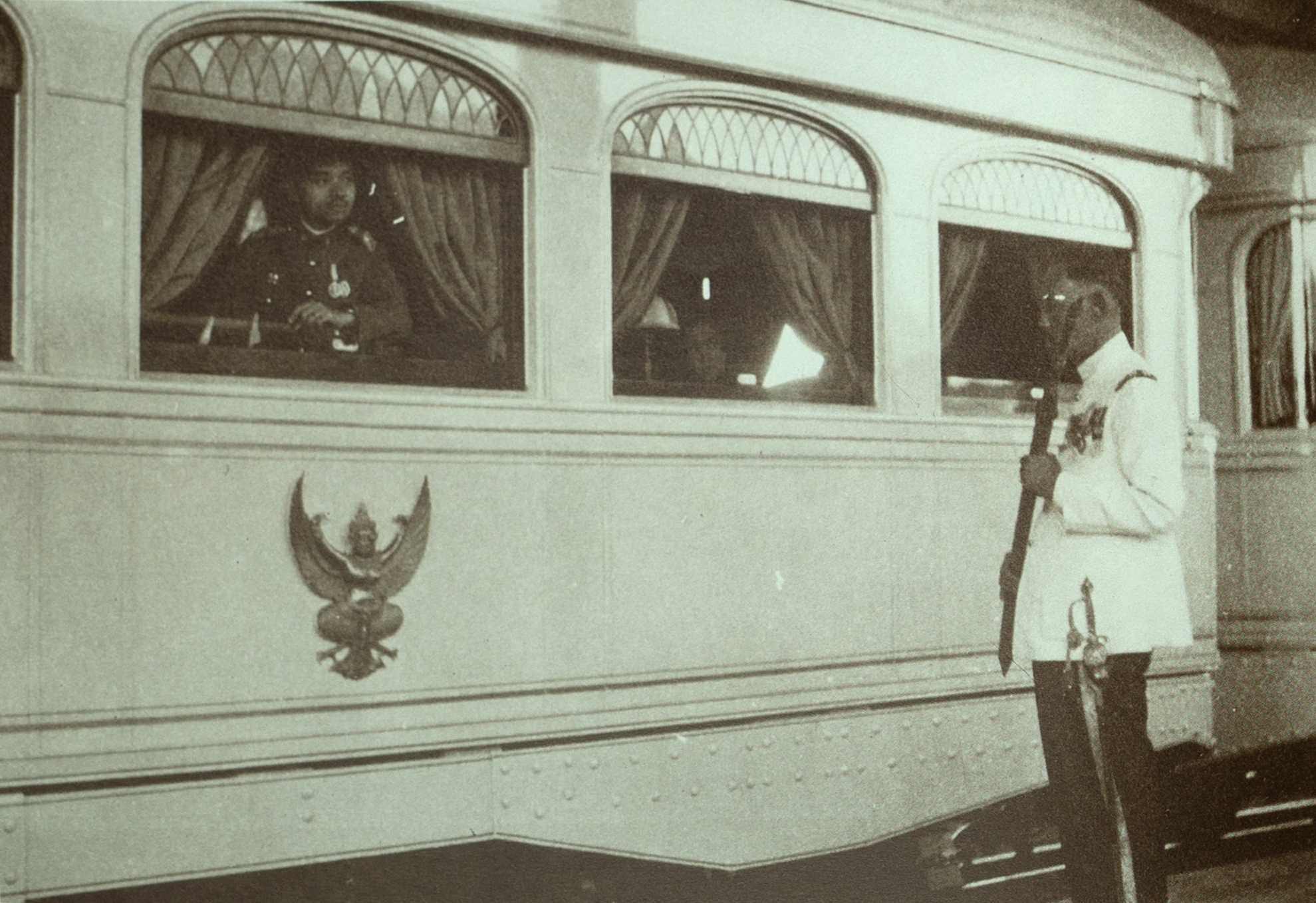

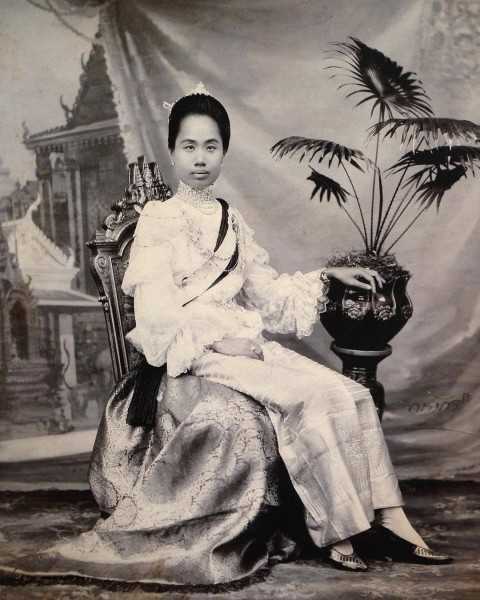
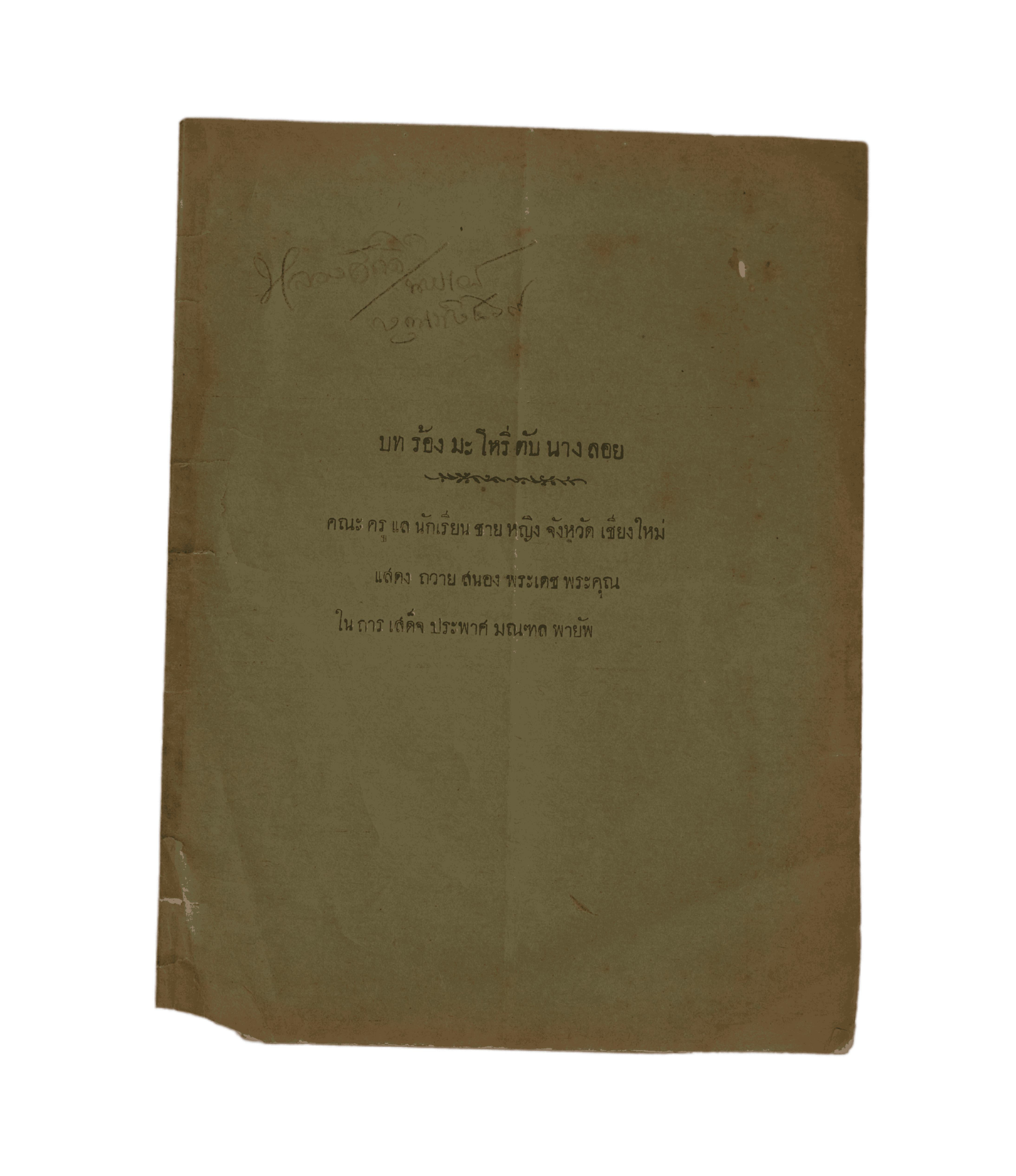

2470

เริ่มมีการพิมพ์ซองแผ่นเสียงในประเทศไทย พบซองแผ่นเสียงของ บริษัท The Siam Gramophone Records Co.,Ltd. มีสัญลักษณ์เป็นรูปช้างสามเศียร มีข้อความบรรยายเกี่ยวกับแผ่นเสียงของบริษัทบนหน้าซอง ดังนี้
| "จานเสียงสุรศัพท์ก้อง | กังวาฬ |
| สมเยี่ยงสมัยกาล | เกริ่นพร้อง |
| ไพเราะมธุระขาน | ไขแจ่มแจ้วเอย |
| เพลงแปลกแผกพจน์ร้อง | เลิศถ้อยคนแถลงฯ |
| ควรแสวงหาแต่เนื้อ | จานดีซื้อนอ |
| เข็มขูดวางบ่มี | พร่าได้ |
| ไฟฟ้าอัดวาที | และเครื่องสังคีตเนอ |
| ฟังวิเวกวังเวงไซร้ | แผ่นนี้เสียงสยามฯ" |
(พฤฒิพล ประชุมพล, ม.ป.ป., น. 153)
The production of record sleeves in Thailand began with examples from The Siam Gramophone Records Co., Ltd., featuring a three-headed elephant logo. The front of the sleeve displayed a poetic description of the company's records as follows:
The sound of the record reverbed, and concordantly compliant to the era.
Sung Melodiously, sweet, and crystal clear.
Novel and foreign but exquisite and graceful.
Seek only the best records, neglect not the needles.
Electricity to record voices, and a machine to melodize, any time, any occasion, only this very record of Siam.
(Pruthipon Prachumphol, n.d.: 153)
2471
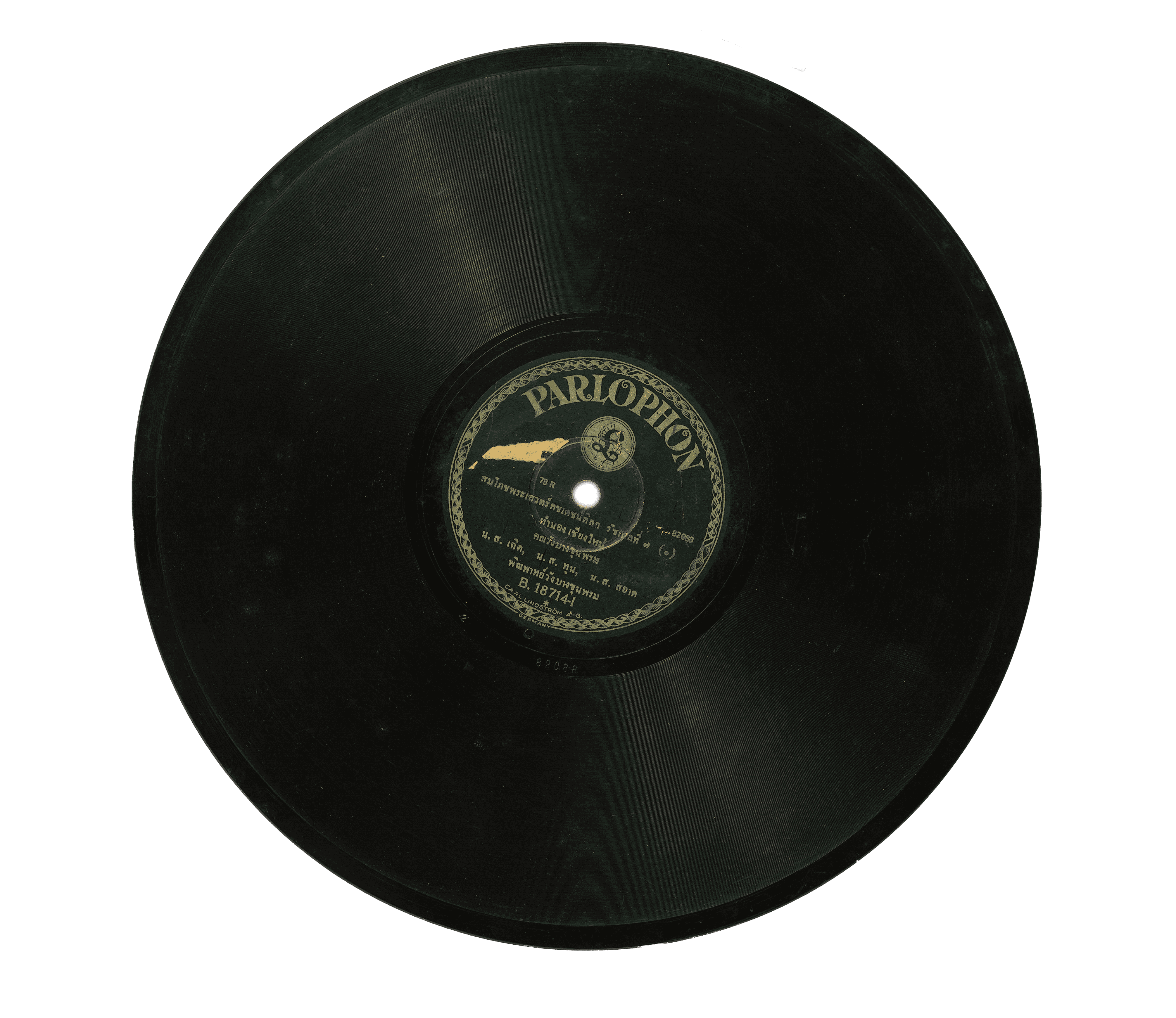
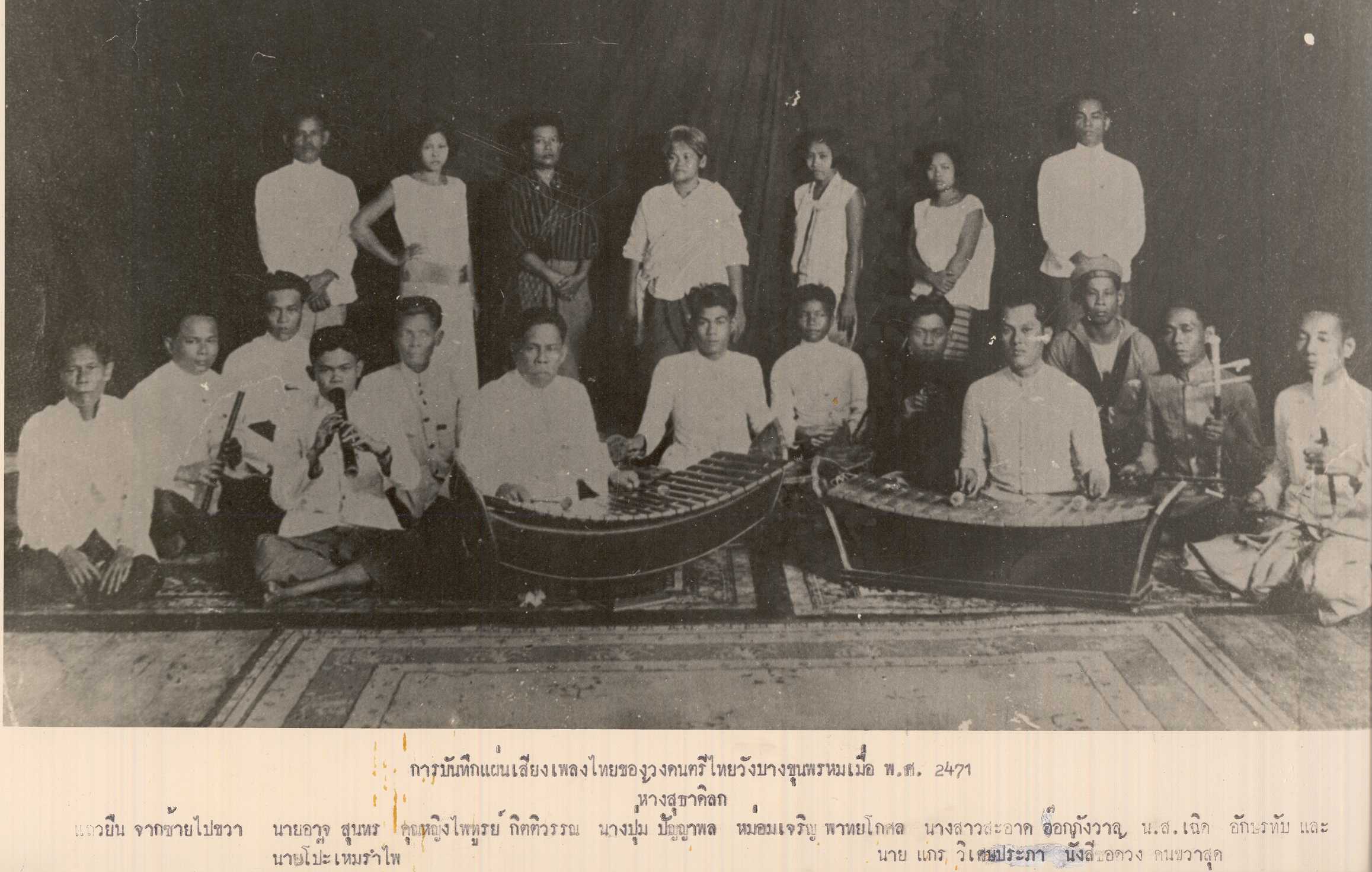
พบแผ่นเสียงเพลงสมโภชช้างเผือก สันนิษฐานว่าบันทึกราวปี พ.ศ. 2471-2473 บนแผ่นเสียงพิมพ์ชื่อเพลงไว้ด้วยอักษรสีทองบนกระดาษกลมสีเขียวแก่ มีข้อความว่า "สมโภชพระเสวตร์คชเดชน์ดิลก" ซึ่งเป็นช้างเผือกคู่พระบารมีพระบาทสมเด็จพระปกเกล้าเจ้าอยู่หัว รัชกาลที่ 7 เมื่อครั้��งเสด็จประพาสมณฑลเชียงใหม่ บรรเลงขับร้องทำนองเชียงใหม่ โดยคณะวังบางขุนพรหม ผู้ขับร้องคือ นางสาวเฉิด (เฉิด อักษรทับ) นางสาวทูน (คุณหญิงไพฑูรย์ กิตติวรรณ) นางสาวสะอาด (สะอาด อ๊อกกังวาล) บันทึกเสียงโดยบริษัท Parlophon Carl Lindstrom A-G ประเทศเยอรมนี (พูนพิศ อมาตยกุล, 2540, น. 244-248)
บทร้องถวายพระพร พระราชชายาเจ้าดารารัศมีทรงโปรดให้ขับร้องเฉลิมพระเกียรติในวันพิธีรับเสด็จฯ มณฑลเชียงใหม่ พูนพิศ อมาตยกุล ถอดเสียงได้ดังนี้
| 1. สา น้อมใจ | ข้าไท ขับกล่อม |
| เถลิงบุญรัตน์ พระยุคลทอง | ใต้ฝ่าละออง ธุลีพระบาท |
| 2. บรมนาถ พระปกเกศเกล้า | ตั้งพระแม่เจ้า บรมราชินี |
| ทรงบุญญฤทธิ์ พระบารมี | เป็นตี้ยินดี ทั่วทุกขอบเขต |
| 3. พระเสื้อทรงเมือง เมลืองฤทธิ์เดช | ทั้งไทเทเวศร์ ก็แสนสุขสันติ์ |
| เป็นศุภนิมิต เศวตทรงธรรม์ | เกิดในเข��ตขันธ์ จังวัดเชียงใหม่ |
| 4. รับเสด็จ..................... | ก็บังเกิดพลาย.......เรืองศรี |
| ปฏิสันธิ์สู่ คู่พระบารมี | กำเนิดมาดี คู่บุญ..... |
| 5. พระบารมี ประชาธิปกโลกนาถ | ปิยะมหาราช หน่อพุทธคุณ |
| คือหน่อให้เชื้อ ประทานการุญ | ให้มาเกิดคู่บุญ….. |
| 6. วันนี้หนา เป็นวันล้ำเลิศ | เป็นวันประเสริฐ ฤกษ์งามยามดี |
| เป็นศุภนิมิต เศวตทรงธรรม์ | เป็นประเพณี สมโภชช้างพลาย |
หมายเหตุ คำร้องที่จับความไม่ได้ จึงละจุดไข่ปลาไว้
Around 1927-1930, a recording of the White Elephant Celebration Song (Pleng Somphoch Chang Puek) from the era of King Rama VII was produced. The record featured the song title inscribed in gold lettering on dark green circular paper, reading "The Celebration of The royal Elephant named 'Samphoch Phra Sawet Kochadet Dilok", referring to the royal white elephant that symbolised the auspicious power of His Majesty King Prajadhipok (Rama VII) during his visit to Chiang Mai. The song was performed in the Chiang Mai style by the Bang Khun Phrom Palace Ensemble, with vocalists named Miss Chert, Miss Thun, and Miss Sa-ard. The recording was made by Parlophon Carl Lindström A-G, a company from Germany. (Poonpit Amatyakul, 1997: 244-248)
Lyrics of Felicitation song that Her Highness Princess Dara Rasmi arranged to honor the welcoming ceremony at Chiangmai.
Poonpit Amatyakul transcribed the lyrics:
With pure hearts, let us sing to glorify the virtue of his majesty, we being nothing but specks of dust compared.
King Prajadhipok, and the queen are of incomparable virtue and nobility, celebrated all over.
Revered we spirits of ancestors, men and angels celebrate alike.
A good fortune, the steward of Dharma arrived in Chiangmai.
We welcome his and her majesty, we glorify his and her radiance.
Indeed a match made in heaven, our beloved king and queen.
He of virtue, King Prajadipok, loved by all, and stood by the principles of Lord Buddha
Such principles emit benevolence and love.
Such a great day it is. A blessed time to live in.
A great fortune indeed, a ceremony of elephants.
Reminder, some lyrics are unable to be transcribed.
2472
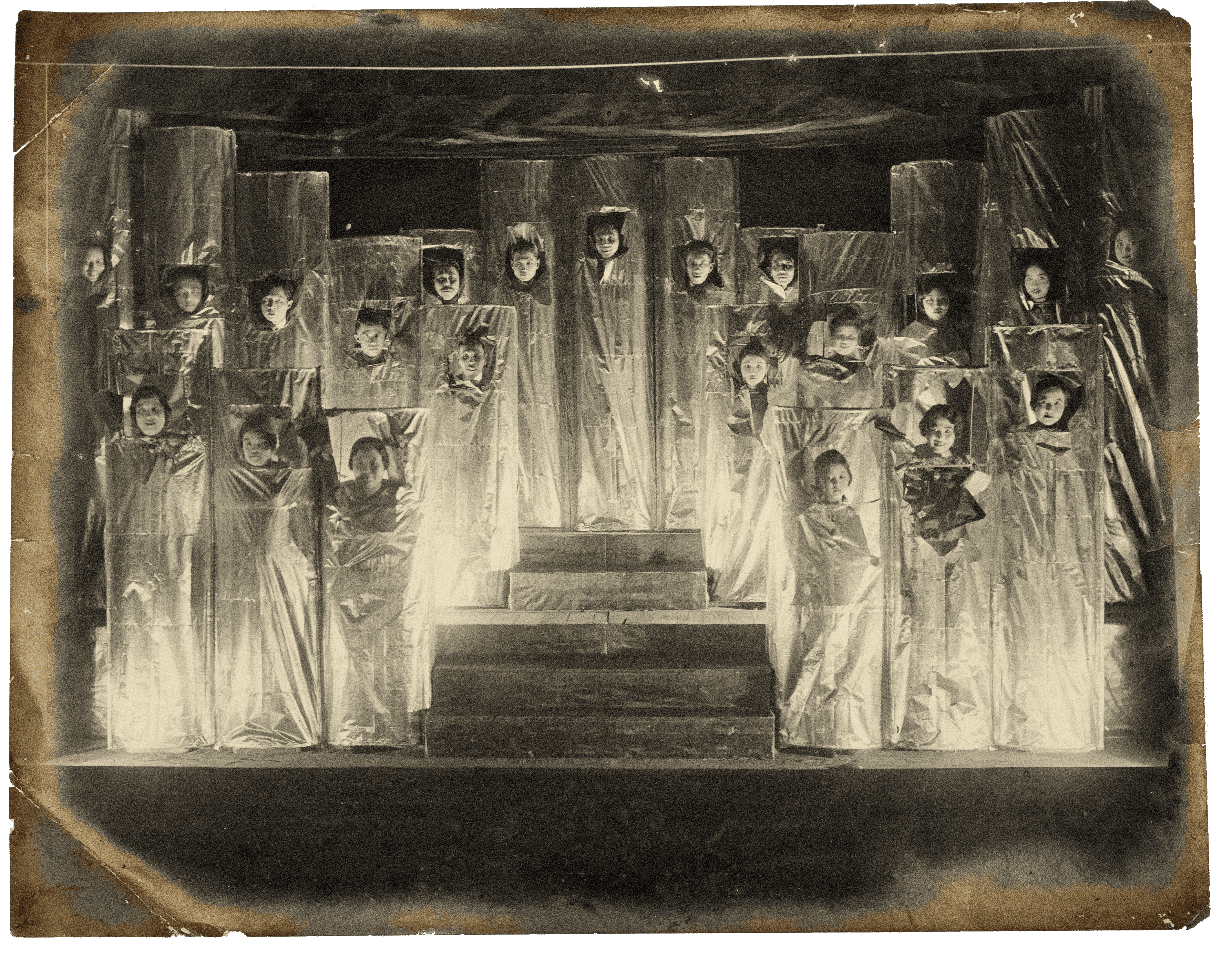
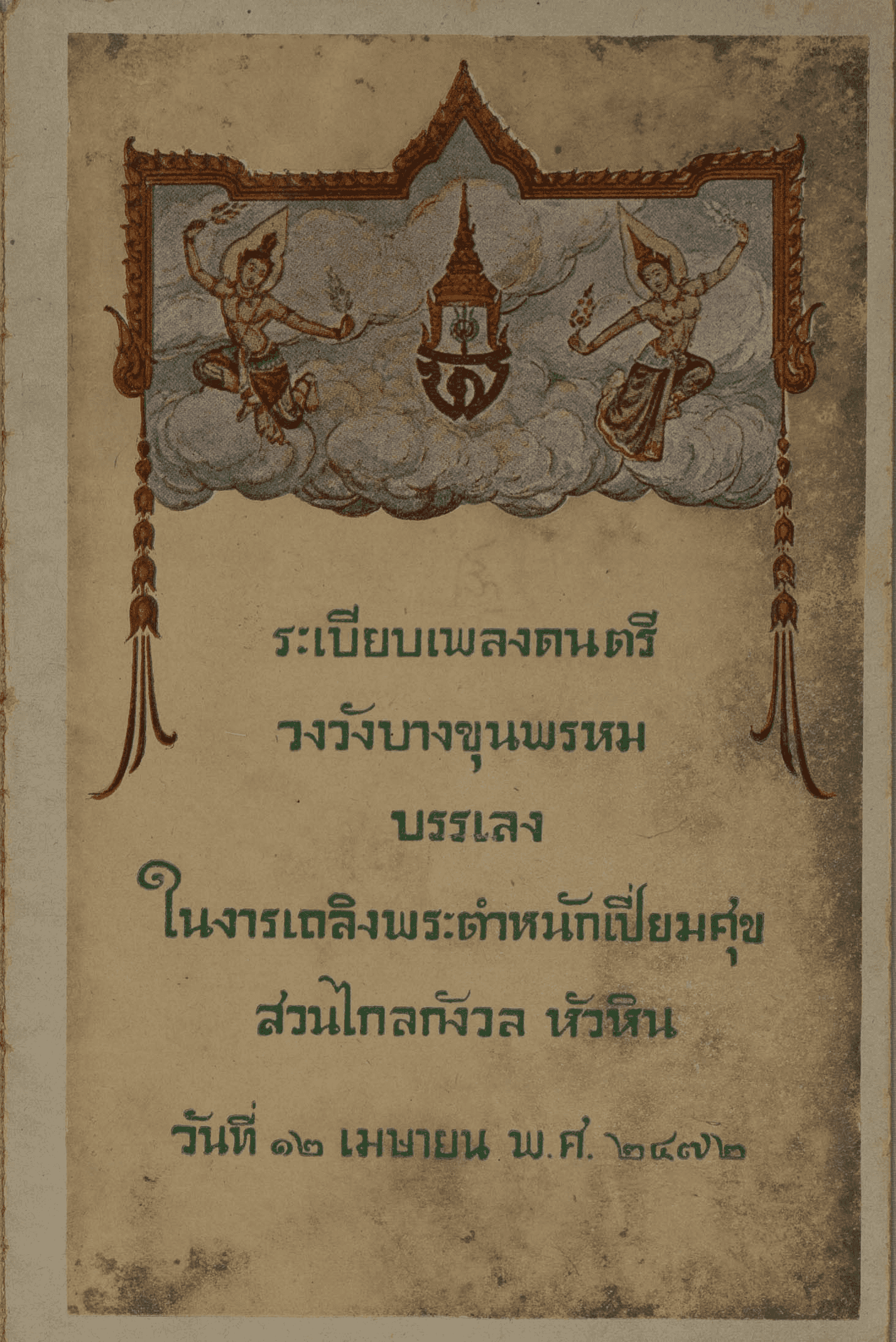
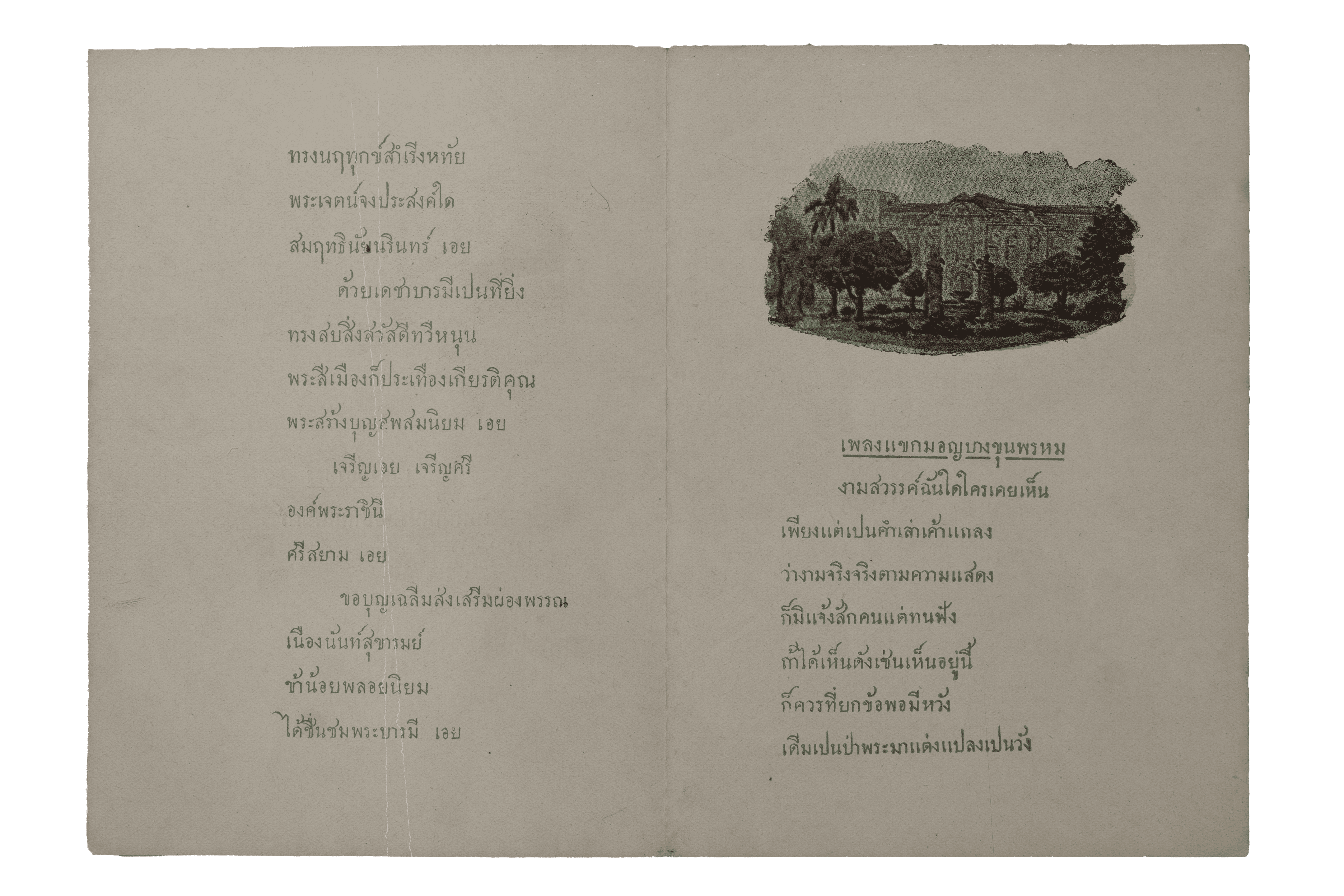
พบแผ่นเสียงเพลงสมโภชช้างเผือก สันนิษฐานว่าบันทึกราวปี พ.ศ. 2471-2473 บนแผ่นเสียงพิมพ์ชื่อเพลงไว้ด้วยอักษรสีทองบนกระดาษกลมสีเขียวแก่ มีข้อความว่า "สมโภชพระเสวตร์คชเดชน์ดิลก" ซึ่งเป็นช้างเผือกคู่พระบารมีพระบาทสมเด็จพระปกเกล้าเจ้าอยู่หัว รัชกาลที่ 7 เมื่อครั้งเสด็จประพาสมณฑลเชียงใหม่ บรรเลงขับร้องทำนองเชียงใหม่ โดยคณะวังบางขุนพรหม ผู้ขับร้องคือ นางสาวเฉิด (เฉิด อักษรทับ) นางสาวทูน (คุณหญิงไพฑูรย์ กิตติวรรณ) นางสาวสะอาด (สะอาด อ๊อกกังวาล) บันทึกเสียงโดยบริษัท Parlophon Carl Lindstrom A-G ประเทศเยอรมนี (พูนพิศ อมาตยกุล, 2540, น. 244-248)
บทร้องถวายพระพร พระราชชายาเจ้าดารารัศมีทรงโปรดให้ขับร้องเฉลิมพระเกียรติในวันพิธีรับเสด็จฯ มณฑลเชียงใหม่ พูนพิศ อมาตยกุล ถอดเสียงได้ดังนี้
| 1. สา น้อมใจ | ข้าไท ขับกล่อม |
| เถลิงบุญรัตน์ พระยุคลทอง | ใต้ฝ่าละออง ธุลีพระบาท |
| 2. บรมนาถ พระปกเกศเกล้า | ตั้งพระแม่เจ้า บรมราชินี |
| ทรงบุญญฤทธิ์ พระบารมี | เป็นตี้ยินดี ทั่วทุกขอบเขต |
| 3. พระเสื้อทรงเมือง เมลืองฤทธิ์เดช | ทั้งไทเทเวศร์ ก็แสนสุขสันติ์ |
| เป็นศุภนิมิต เศวตทรงธรรม์ | เกิดในเขตขันธ์ จังวัดเชียงใหม่ |
| 4. รับเสด็จ..................... | ก็บังเกิดพลาย.......เรืองศรี |
| ปฏิสันธิ์สู่ คู่พระบารมี | กำเนิดมาดี คู่บุญ..... |
| 5. พระบารมี ประชาธิปกโลกนาถ | ปิยะม��หาราช หน่อพุทธคุณ |
| คือหน่อให้เชื้อ ประทานการุญ | ให้มาเกิดคู่บุญ….. |
| 6. วันนี้หนา เป็นวันล้ำเลิศ | เป็นวันประเสริฐ ฤกษ์งามยามดี |
| เป็นศุภนิมิต เศวตทรงธรรม์ | เป็นประเพณี สมโภชช้างพลาย |
หมายเหตุ คำร้องที่จับความไม่ได้ จึงละจุดไข่ปลาไว้
On April 10th-11th, His Majesty King Prajadhipok (Rama VII) graciously ordered the organization of the royal housewarming ceremony at Phra Tamnak Piamsuk, Klai Kangwon Palace. Following this, on April 12th, members of the royal family and court officials jointly organized the "Klai Kangwon Revue" at the Sala Roeng Pavilion. The event featured musical performances by His Majesty's personal Thai music ensemble, the Bang Khun Phrom Palace ensemble, and the Amphorn Western music band. There were satirical performances parodying ministers from various ministries, along with a Thai song-guessing game, where performers dressed in costumes and acted out clues on stage for musicians to guess and play the corresponding songs. (Sukhothai Thammathirat Open University Library, retrieved February 5, 2025)
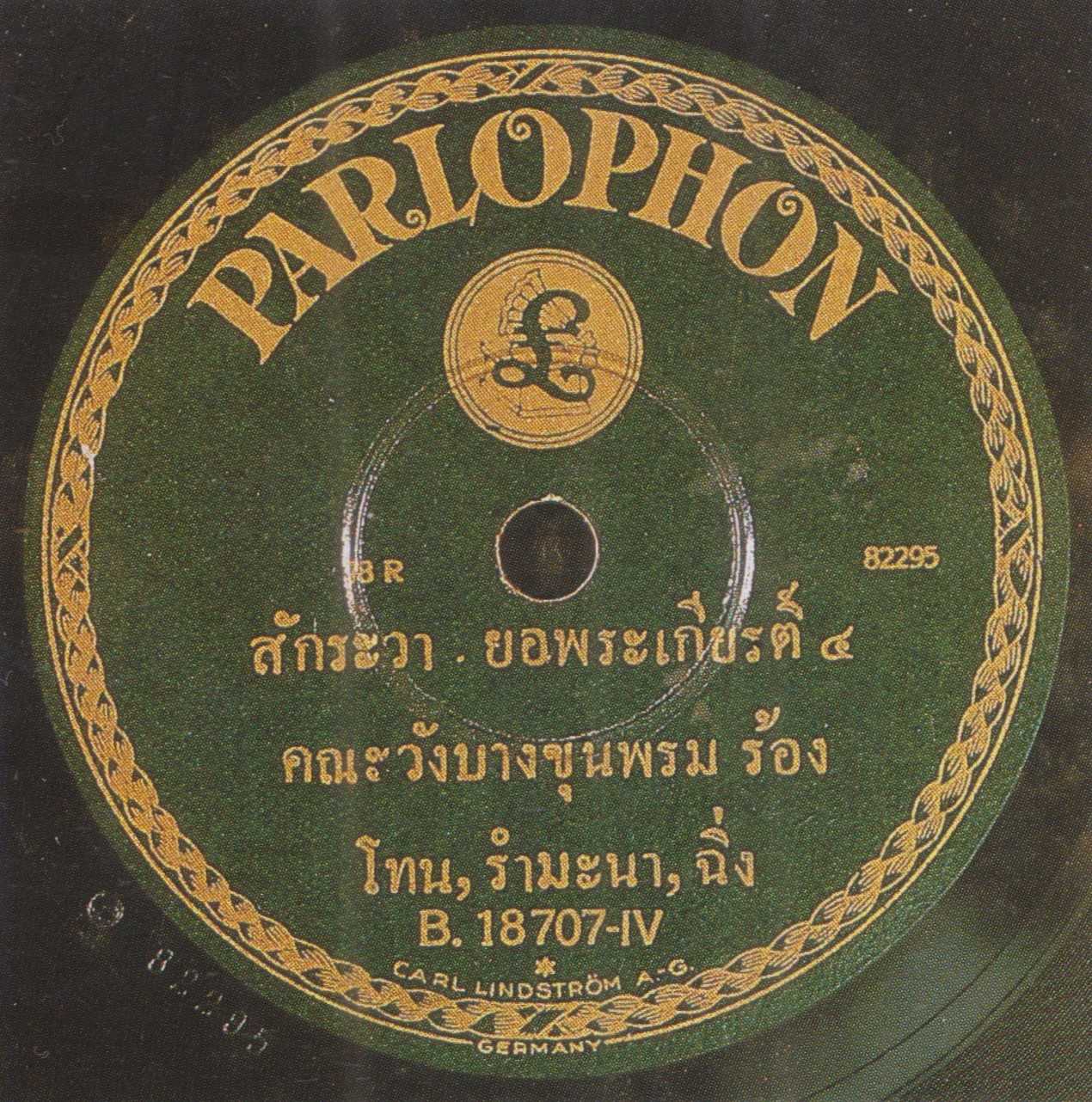
วันที่ 29 มิถุนายน เป็นคล้ายวันประสูติครบรอบพระชนมายุ 48 พร�รษา ของสมเด็จพระเจ้าบรมวงศ์เธอ เจ้าฟ้าบริพัตรสุขุมพันธุ์ กรมพระนครสวรรค์วรพินิจ พ.ศ. 2472 ปีมะเส็ง มีการจัดงานสี่มะเส็ง ครั้งนั้นได้ทำการบันทึกแผ่นเสียงโดยใช้ชื่อ "คณะวังบางขุนพรหม" พบงานบันทึกเสียงแผ่น "เพลงระบำงูกินหาง" และ "สักวายอพระเกียรติ" เป็นแผ่น Columbia และ Parlophon หน้าสีเขียว (พูนพิศ อมาตยกุล, 2540, น. 173-176)
During the celebration of the 48th birthday anniversary in the Year of the Snake, 1929, Si Mareng event was held, phonograph recordings were recorded under the name of "Bang Khun Phrom Palace Ensemble." Among the discovered records are performances of "Rabum Ngu kin hang" (The Snake-Eating-Its-Tail Dance) and "Sakawa Yau Phra Kiat" (Form of Thai Poetry in Honor of Royal Prestige). These recordings were issued on Columbia and Parlophone, with green-colored labels.(Poonpit Amatyakul, 1997: 173-176)
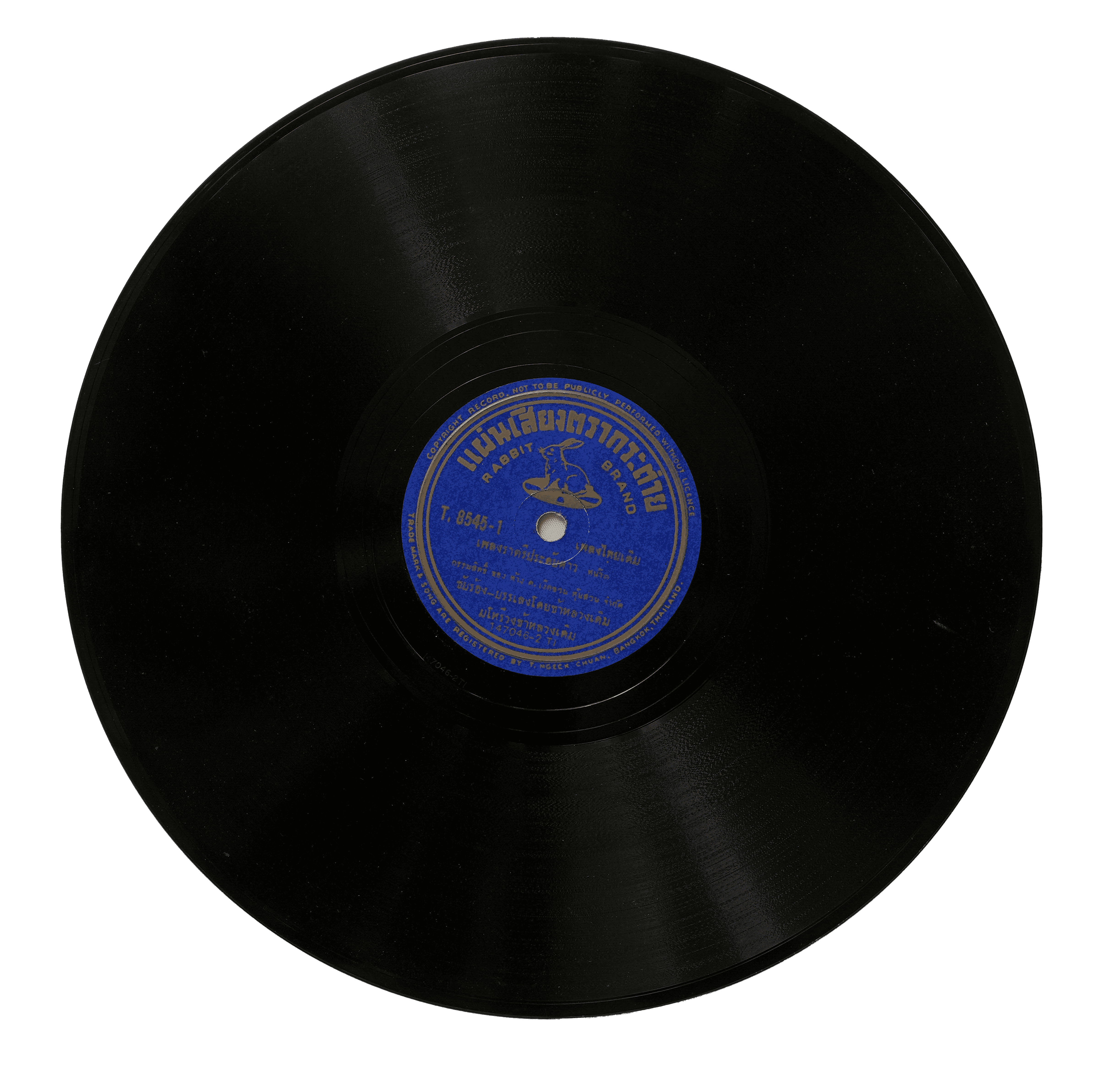
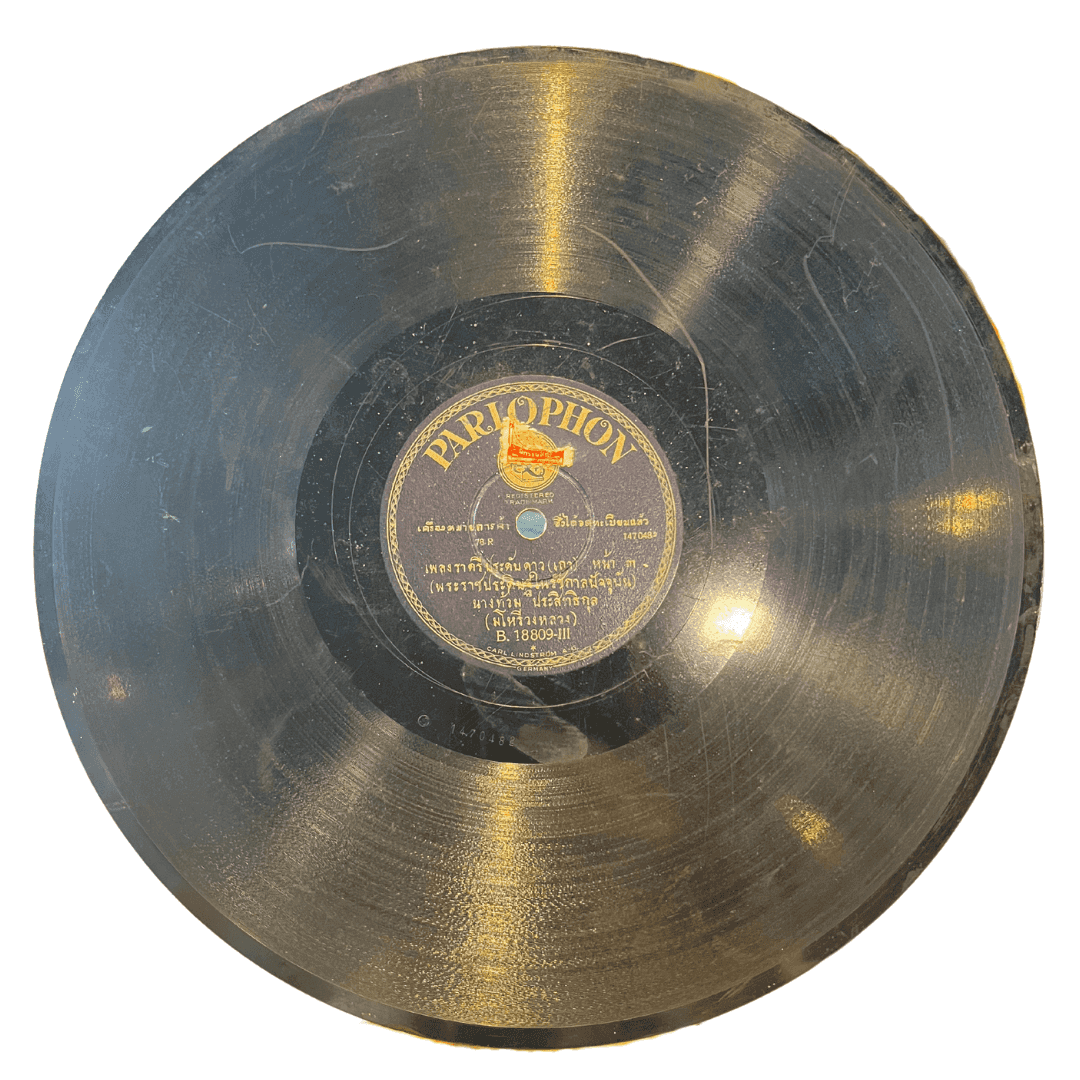
ในปี พ.ศ. 2472 สมเด็จพระปกเกล้าเจ้าอยู่หัว ได้ทรงพระราชนิพนธ์เพลงราตรีประดับดาว ซึ่งเป็นการเลียนล้อจากเพลงแขกมอญบางขุนพรหม อันเป็นพระนิพนธ์ของสมเด็จฯ เจ้าฟ้ากรมพระนครสวรรค์วรพินิต เพลงราตรีประดับดาวมีบทร้องตอนหนึ่งที่ว่า "ขอเชิญเจ้าฟังเพลงวังเวงใจ เพลงของท่านแต่งใหม่ในวังหลวง" เพื่อเป็นที่หมายรู้ว่าพระบาทสมเด็จพระเจ้าอยู่หัวเป็นผู้พระราชนิพนธ์ในพระบรมมหาราชวัง (วังหลวง) (วิเชียร กุลกัณฑ์ และมนตรี ตราโมท, 2523, น. 440-444) และขับร้องออกอากาศครั้งแรกที่สถานีวิทยุ ศาลาแดง 1 1 พีเจ (อัษฎาวุธ สาคริก, การสื่อสารส่วนบุคคล, 4 กุมภาพันธ์ 2568)
In 1929, His Majesty King Prajadhipok (Rama VII) composed the song "Ratri Pradab Dao" (Star-Adorned Night), which was inspired by the song "Khaek Mon Bang Khun Prom" by His Royal Highness Prince Krom Phra Nakhon Sawan Worapinit. The song "Ratri Pradab Dao" includes a verse, "Please listen to this song that stirs the heart, a new composition from the Grand Palace," serving as a subtle indication of the King's authorship within the royal residence. (Wichian Kulkhan and Montri Tramot, 1980, pp. 440-444). The song was first broadcast on the radio station at Sala Daeng on January 1st (Atsadawut Sagarik, personal communication, February 4, 2025).
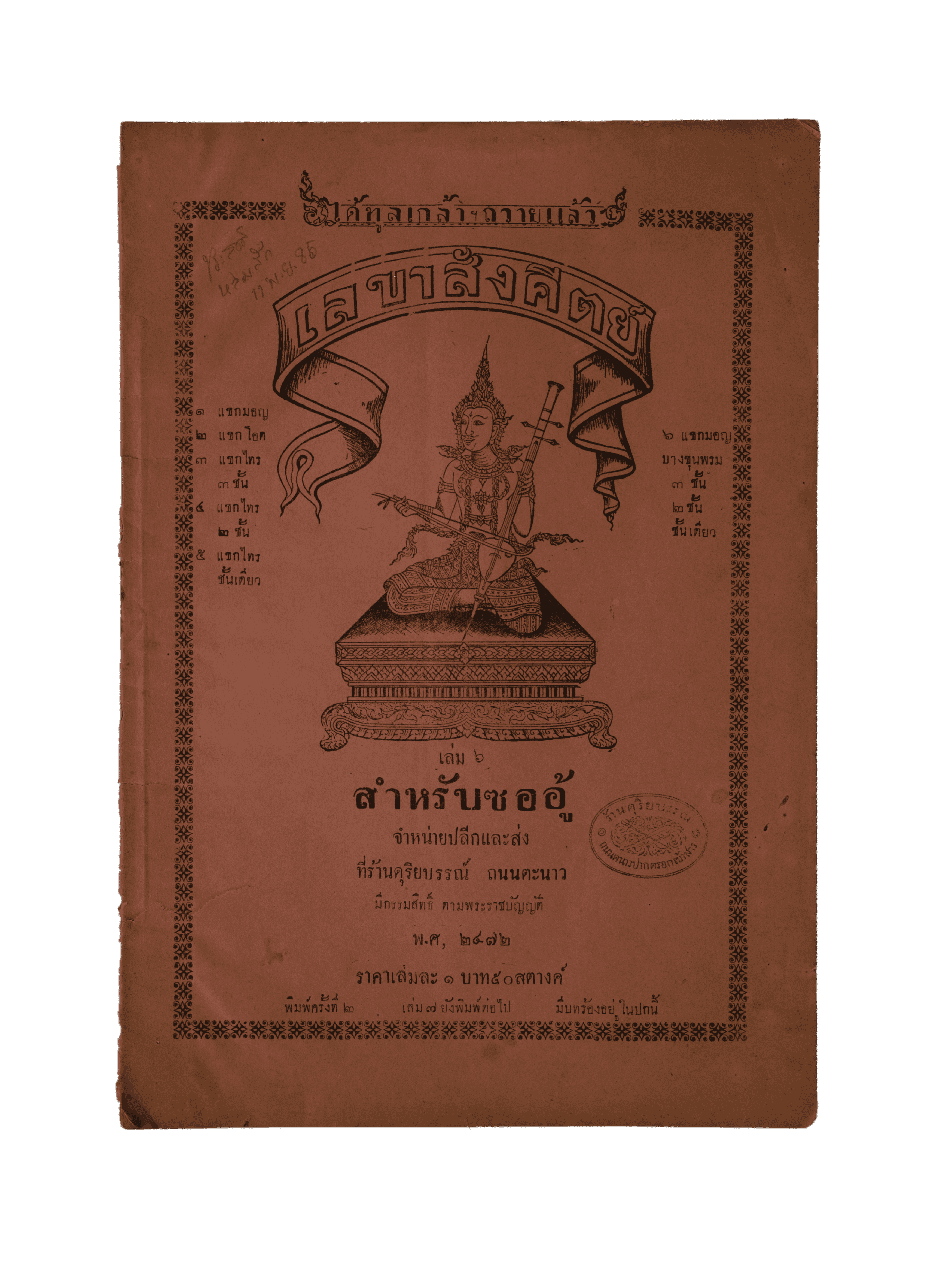
พบการบันทึกโน้ตเพลงและบทร้องทูลเกล้าฯ ถวายพระบาทสมเด็จพระปกเกล้าเจ้าอยู่หัว ต่อมานำมาจำหน่ายโดยร้านดุริยบรรณ์ ถนนตะนาว ชื่อเลขาสังคีตย์ บนปกปรากฏราคาจำหน่ายเล่มละ 1 บาท 50 สตางค์ (อัษฎาวุธ สาคริก, การสื่อสารส่วนบุคคล, 4 กุมภาพันธ์ 2568)
A record musical score and lyrics were found and respectfully presented to His Majesty King Prajadhipok (Rama VII). Later, it was published and sold by Duriyabun Shop on Tanao Road under the title Lekhasangkheet. The cover displayed the selling price of 1 baht and 50 satang per copy. (Atsadawut Sakrik, personal communication, February 4, 2025)
2473
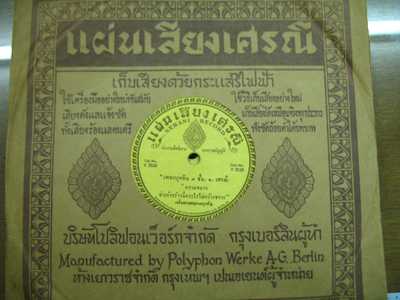
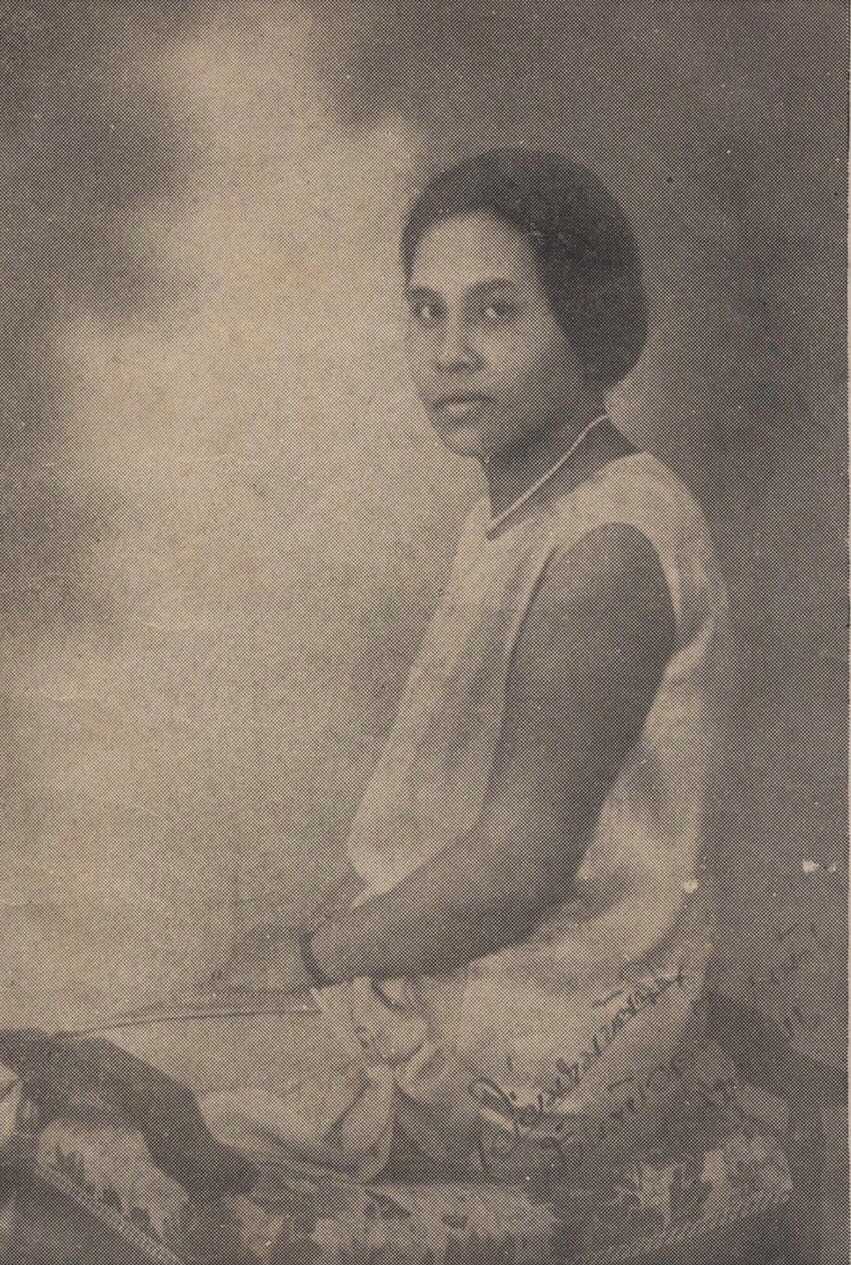
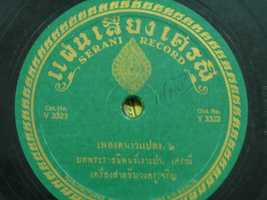
เดือนเมษายน 2473 พระบาทสมเด็จพระปกเกล้าเจ้าอยู่หัวและสมเด็จพระนางเจ้ารำไพพรรณี พระบรมราชินี เสด็จฯ ประพาสอินโดจีนและทรงทอดพระเนตรดนตรีและการแสดงชุดต่าง ๆ (วิบูลย์สวัสดิวงศ์ สวัสดิกุล, ม.จ., 2495)
ในช่วงปี พ.ศ. 2473-2485 กรมพระยาดำรงราชานุภาพ ได้รับสั่งให้เจ้าพระยาวรพงศ์พิพัฒน์ (ม.ร.ว.เย็น อิศรเสนา) เสนาบดีกระทรวงวัง เจ้ากรมปี่พาทย์หลวงในขณะนั้นจัดหาครูดนตรีไทยและผู้เชี่ยวชาญการจดโน้ตเพลงมาร่วมกันบรรเลงบอกเพลงและบันทึกโน้ตดนตรีไทยโดยเริ่มจดบันทึกโน้ตสากลเมื่อวันท�ี่ 19 กุมภาพันธ์ ที่ท้องพระโรงวังวรดิศ (วิภา จิรภาไพศาล, 2566)
คุณหญิงรามบัณฑิตสิทธิเศรณี (เยี่ยม สุวงศ์) เป็นผู้ที่มีชื่อเสียงด้านการขับร้องและเคยเป็นข้าหลวงในสังกัดวังพระวิมาดาเธอ พระองค์เจ้าสายสวลีภิรมย์ กรมพระสุธาสินีนาฏ และมีโอกาสได้เรียนขับร้องจากหม่อมส้มจีน หม่อมคร้ามและคุณเฒ่าแก่จีบ (ศิวศิลป์ จุ้ยเจริญ, 2568; ชีวิน สุวงศ์, 2493: 25-43) อีกทั้งเป็นผู้บันทึกแผ่นเสียง โดยทำสัญญากับบริษัทพาร์โลโฟน (Polyphone Werke A.G. Berlin) ของประเทศเยอรมนี ทำการอัดแผ่นเสียงและใช้ชื่อของท่านตราว่า แผ่นเสียงเศรณี มีตราเป็นรูปอุณาโลม รุ่นแรก ๆ พิมพ์บนกระดาษสีเขียวมีตัวหนังสือสีทอง อัดด้วยไฟฟ้า
(พูนพิศ อมาตยกุล, 2540, น. 194-199)
In April 1930, His Majesty King Prajadhipok (Rama VII) and Her Majesty Queen Rambhai Barni traveled to the Indochina peninsula, where they observed various musical performances and shows. (Vibulsawasdiwong Sawaddikun, M.C., 1952)
Between 1930 and 1942, Prince Damrong Rajanubhab ordered Phaya Woraphongpipat (M.R. Yen Isarasena), the Minister of the Ministry of the Palace and the head of the royal piphat ensemble at that time, to gather Thai music teachers and experts in musical notation to perform, transcribe, and record Thai music. The first attempt to write Western musical notation began on February 19th at the Thong Phra Rong Hall in Wang Woradis. (Wipa Jiraphapai-San, 2023)
Khun Ying Rambandit Sittiseranee (Yiam Suwong) made phonograph recordings under a contract with Polyphone Werke A.G. Berlin, a German company. The records, branded with her name, were issued under the label "Seranee" and featured the emblem of the unalome, a symbol of auspiciousness. The early editions of these records were printed on green-colored paper with gold lettering and were electrically recorded. (Poonpit Amatyakul, 1997: 194-199)
2474
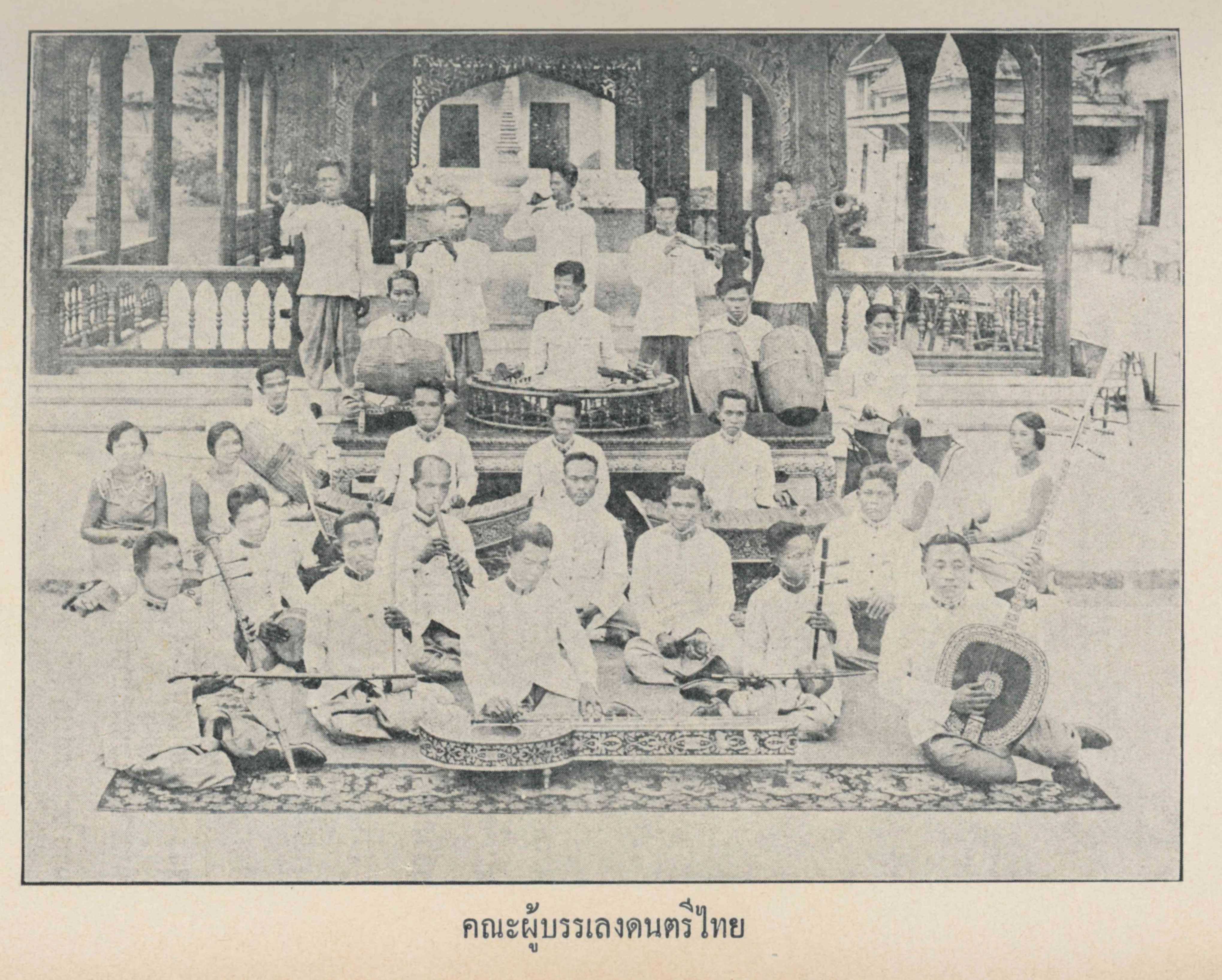
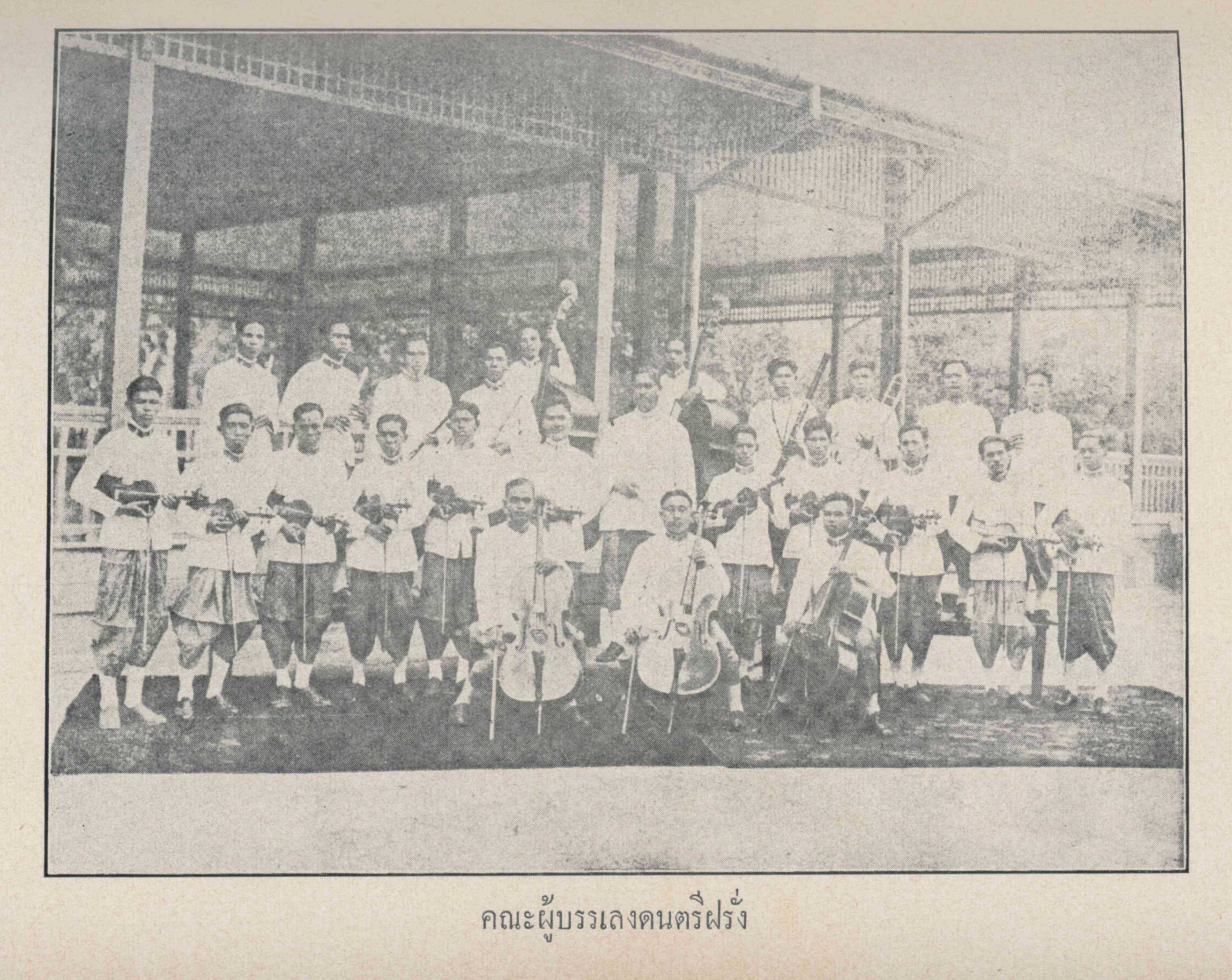


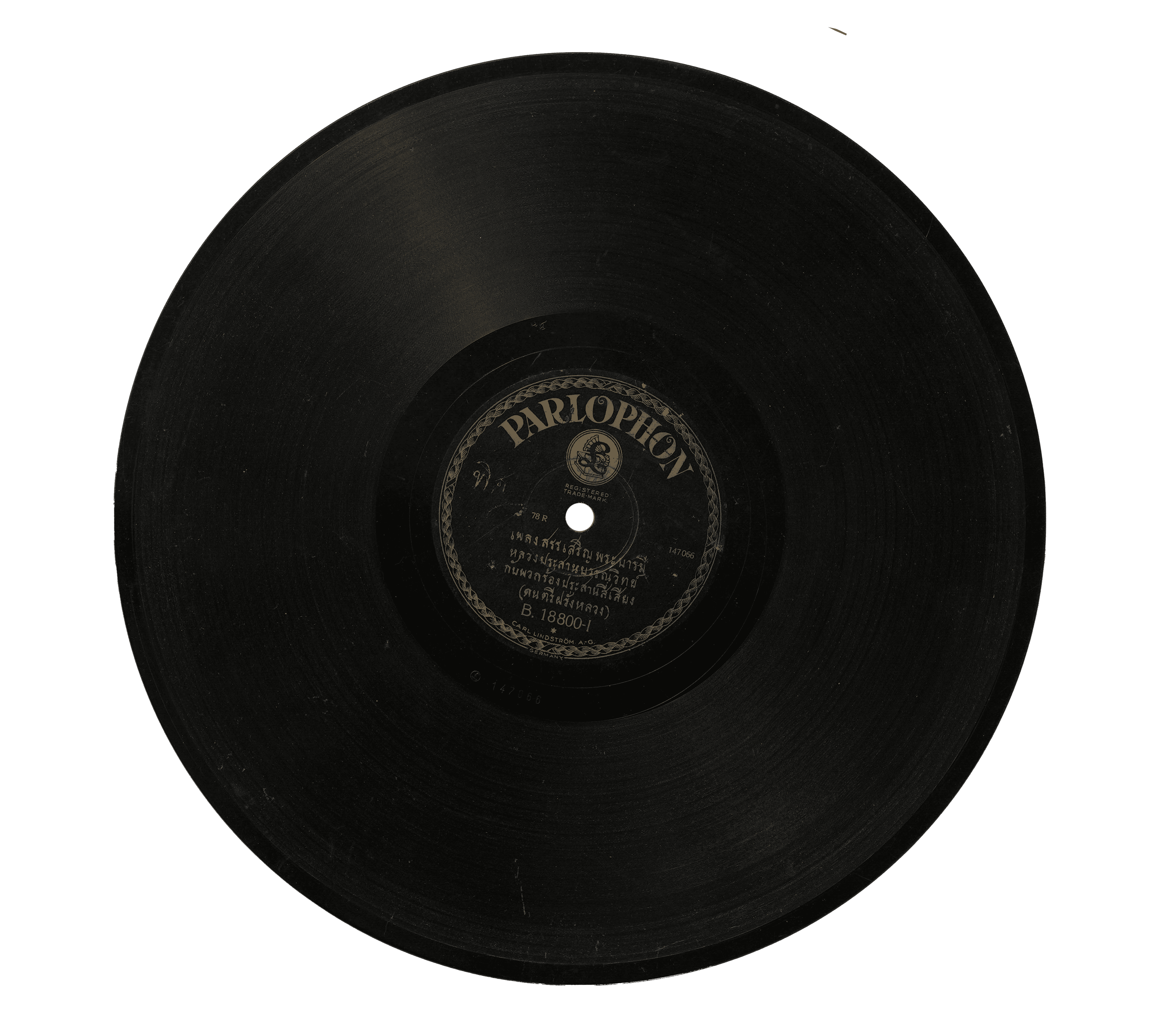
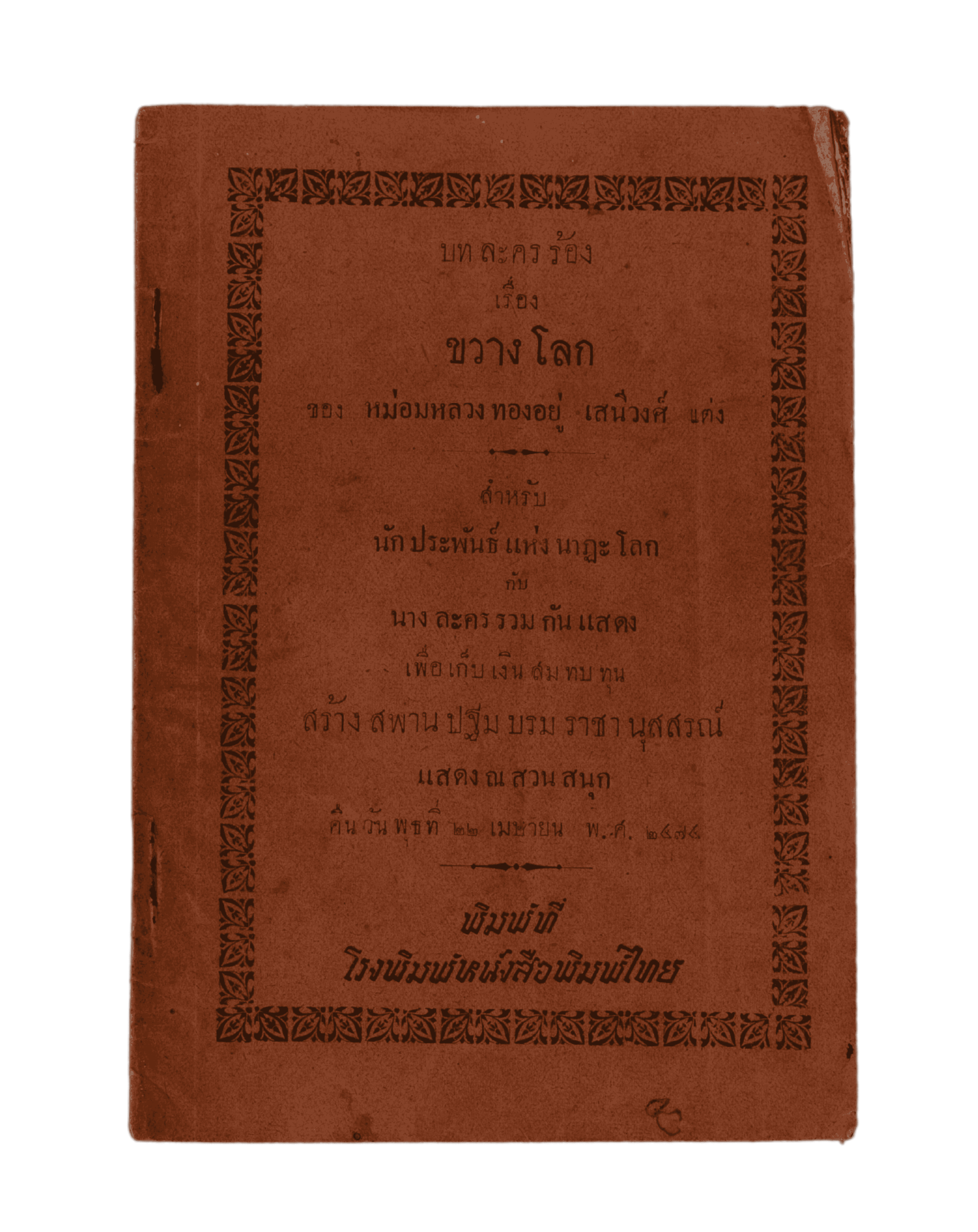
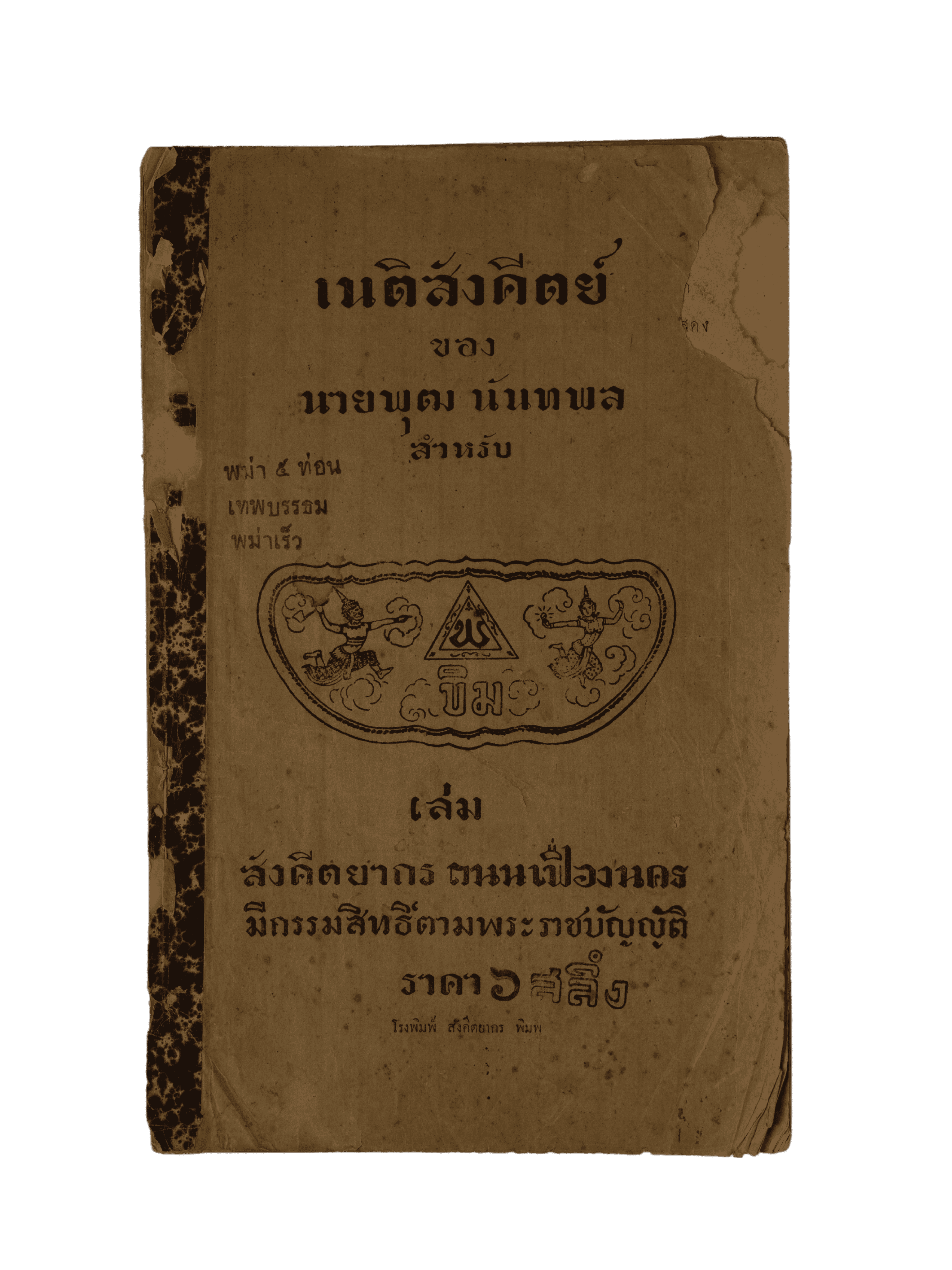
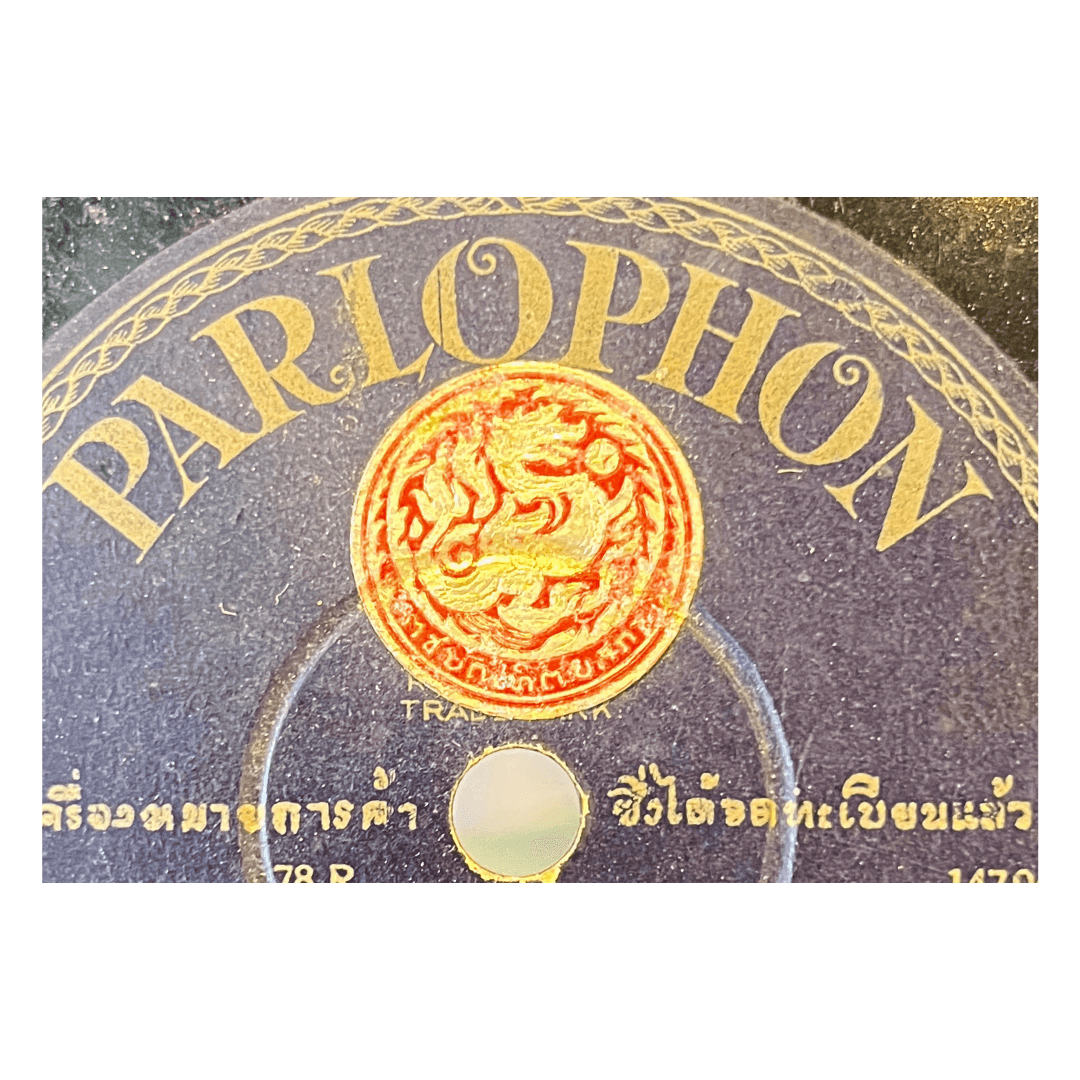
สมเด็จฯ กรมพระยาดำรงราชานุภาพ ขณะทรงเป็นนายกราชบัณฑิตยสภา ทรงริเริ่มและดำเนินงานบันทึกเพลงไทยโดยความร่วมมือของ อัคราชทูตของเยอรมัน รูดอล์ฟ อัสมิส (Rudolf Asmis) ติดต่อตัวแทนบริษัทแผ่นเสียงเยอรมันให้ช่วยบันทึกเสียงโดยไม่คิดค่าใช้จ่าย และให้ชื่อแผ่นเสียงว่า "แผ่นเสียงราชบัณฑิตยสภา" ดำเนินการช่วงเดือนสิงหาคม-ตุลาคม พ.ศ. 2474 โดยมี หม่อมเจ้าหญิงพัฒนายุ ดิศกุล เป็นผู้อำนวยการโครงการงานจัดพิมพ์บทแผ่นเสียงของหม่อมเจ้าหญิงพัฒนายุ (เหลือ) ดิศกุล สำเร็จภายหลังเปลี่ยนแปลงการปกครองจากระบอบสมบูรณาญาสิทธิราชย์เป็นระบอบประชาธิปไตยตามรัฐธรรมนูญ จึงนำหนังสือบทแผ่นเสียงทูลเกล้าฯ ถวายพระบาทสมเด็จพระปกเกล้าเจ้าอยู่หัว (บทแผ่นเสียงของราชบัณฑิตยสภา, 2517)
พบสมุดโน้ตเพลง เนติสังคีต ของ นายพุฒ นันทพล สำหรับขิม เพลงพม่า 5 ท่อน เ��ทพบรรทม พม่าเร็ว ราคา 6 สลึง พิมพ์โดยโรงพิมพ์สังคีตยากร และสมุดบทละครร้อง เรื่องขวางโลก ของหม่อมหลวงทองอยู่ เสนีวงศ์ เพื่อเก็บเงินสมทบทุนสร้างสะพานปฐมบรมราชานุสรณ์ (สะพานพระพุทธยอดฟ้า) แสดง ณ สวนสนุก คืนวันพุธที่ 22 เมษายน พ.ศ. 2474 พิมพ์ที่โรงพิมพ์หนังสือพิมพ์ไทย (อัษฎาวุธ สาคริก, การสื่อสารส่วนบุคคล, 4 กุมภาพันธ์ 2568)
While being in position as the President of the Royal Society, His Royal Highness Prince Tisavarakumarn, the Prince Damrong Rajanubhab pioneered and oversaw the recording of Thai music in collaboration with the German Ambassador, Rudolf Asmis. He contacted representatives of a German phonograph company, requesting their assistance in recording the music at no charge. The recordings were named "the Royal Society Phonograph Records" and were carried out between August and October 1931. The project was overseen by Her Royal Highness Princess Phatthanayu (Leua) Diskul. The publication of the disc recordings of Royal Highness Princess Phatthanayu (Leua) Diskul was completed after the change in the system of government from an absolute monarchy to a constitutional democracy. Therefore, the book of disc recordings was presented to His Majesty King Prajadhipok (Rama VII). (Recordings by the Royal Institute, 1974).
A musical score compilation book titled Neti Sangita by Mr. Phut Nantaphon for the khim, featuring songs such as "Burmese 5 Sections," "Thep Bantham," and "Burmese Fast." Priced at 6 salueng, it was printed by Sangkheetyakorn Press. Additionally, there was a booklet of a musical play Kwang Lok by Mom Luang Thong Yuu Seneewong, which was produced to raise funds for the construction of the Phatthom Borom Rajanusorn Bridge (Phra Phutthayotfa Bridge), performed at the amusement park on the evening of Wednesday, April 22, 1931 (B.E. 2474), printed by Thai Newspaper Press. (Asadawut Sakorik, personal communication, February 4, 2025)
2475
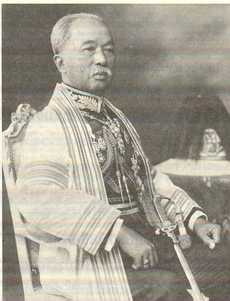
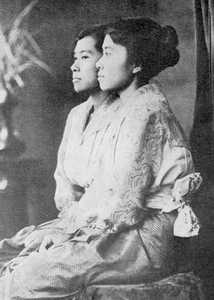
สมเด็จพระเจ้าบรมวงศ์เธอ กรมพระยาดำรงราชานุภาพ และ หม่อมเจ้าหญิงพัฒนายุ ดิศกุล ผู้อำนวยการจัดทำแผ่นเสียงของราชบัณฑิตยสภา
งานจัดพิมพ์บทแผ่นเสียงของหม่อมเจ้าหญิงพัฒนายุ (เหลือ) ดิศกุล สำเร็จภายหลังเปลี่ยนแปลงการปกครองจากระบอบสมบูรณาญาสิทธิราชย์เป็นระบอบประชาธิปไตยตามรัฐธรรมนูญ จึงนำหนังสือบทแผ่นเสียงทูลเกล้าฯ ถวายพระบาทสมเด็จพระปกเกล้า�เจ้าอยู่หัว (บทแผ่นเสียงของราชบัณฑิตยสภา, 2517)
The publication of the disc recordings of Royal Highness Princess Phatthanayu (Leua) Diskul was completed after the change in the system of government from an absolute monarchy to a constitutional democracy. Therefore, the book of disc recordings was presented to His Majesty King Prajadhipok (Rama VII). (Recordings by the Royal Institute, 1974).
2476
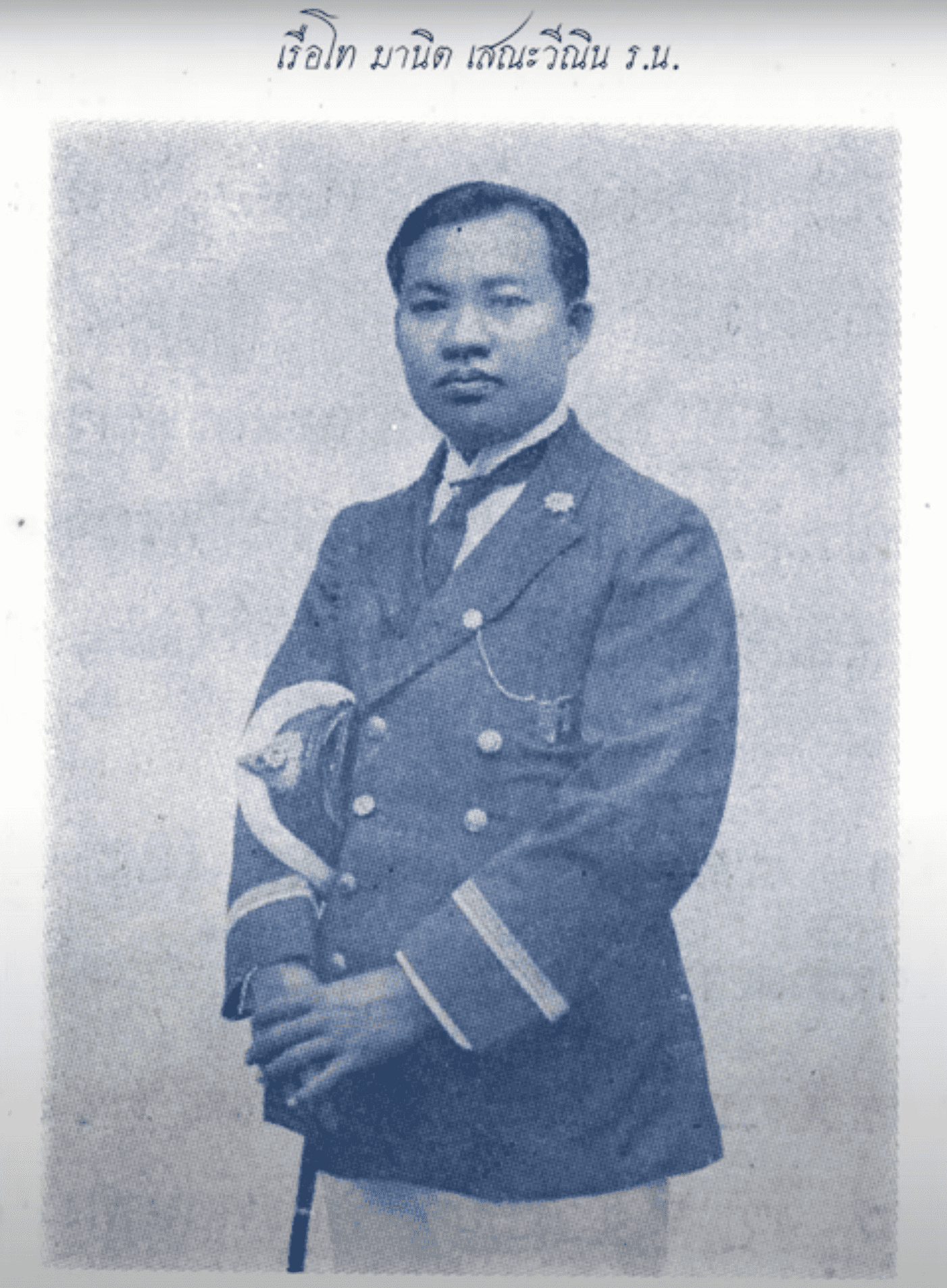
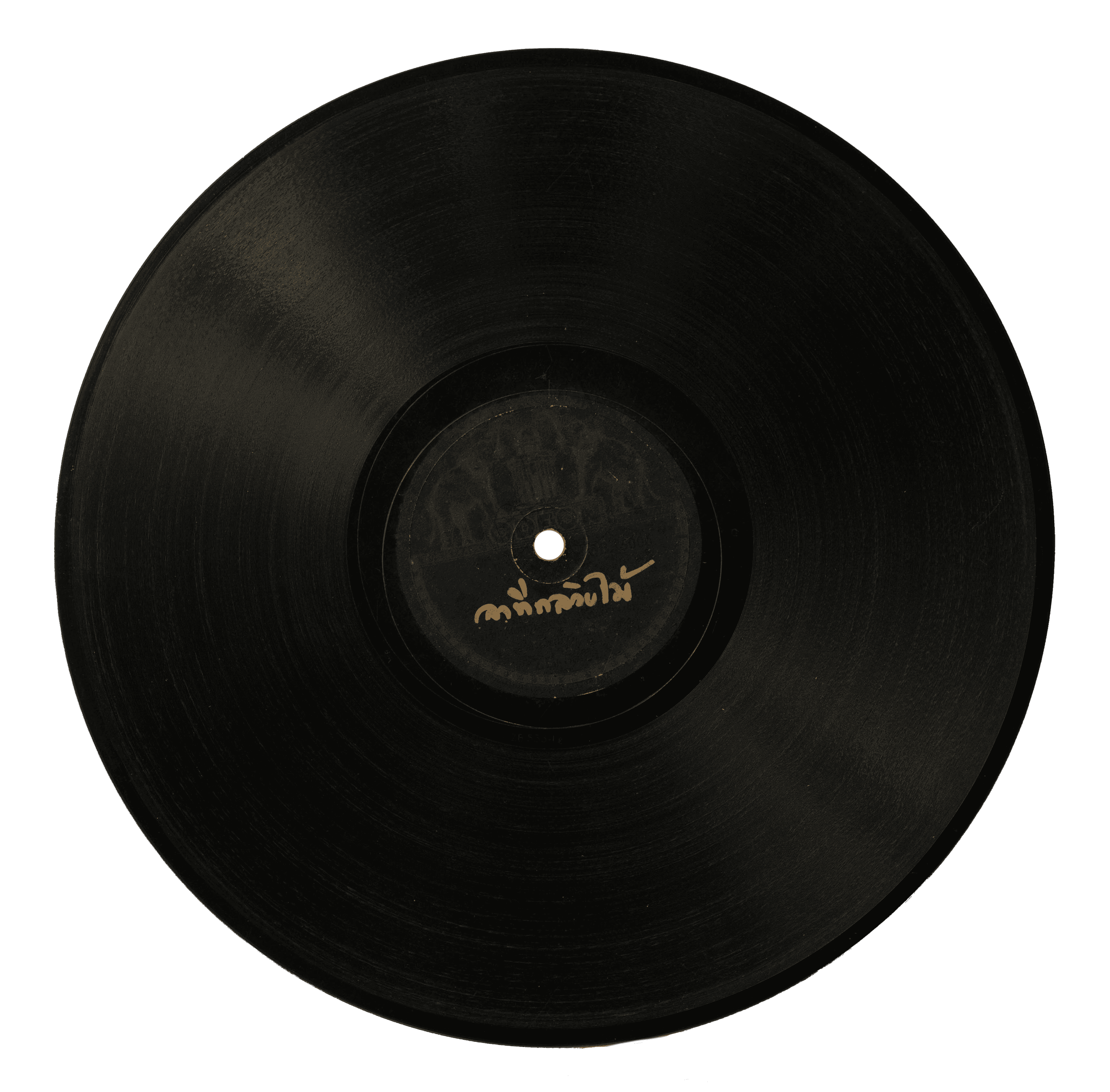
เอกสารลายพระหัตถ์ของสมเด็จฯ กรมพระยาดำรงราชานุภาพมีไปถึงพระราชวรวงศ์เธอ กรมหมื่นพิทยาลงกรณ์ นายกราชบัณฑิตยสภาในเวลานั้นและเจ้าพระยาวรพงษ์พิพัฒน์ (ม.ร.ว.เย็น อิศรเสนา) เสนาบดีกระทรวงวังใน พ.ศ. 2476 ระบุว่า บริษัทฮัมบูร์ก-สยามส่งแผ่นเสียงงวดที่ 1 จำนวน 3 ชุด 45 แผ่นมาให้ราชสำนัก (สำนักหอจดหมายเหตุแห่งชาติ ก, 2476, สำนักหอจดหมายเหตุแห่งชาติ ข, 2476)
พบแผ่นเสียง "ลาทีกล้วยไม้" เพลงจากภาพยนตร์เสียงศรีกรุง เรื่อง ปู่โสมเฝ้าทรัพย์ เป็นเพลงไทยสากลจังหวะรัมบ้าเพลงแรกที่ปรากฏในภาพยนตร์ไทย ประพันธ์คำร้องโดย ขุนวิจิตรมาตรา (สง่า กาญจนาคพันธุ์) ทำนองโดย เรือโท มานิต เสณะวีณิน แปลงมาจากเพลงไทยสำเนียงมอญชื่อ ตับมอญกละ นางสาวมณี บุญจมานนท์ และ นางสาวองุ่น เครือพันธุ์ ขับร้อง วงดนตรีแจ๊สศรีกรุง ในจ�ังหวะรัมบ้า บันทึกลงแผ่นเสียง ODEON ตรา ตึก - ช้างคู่ ประเทศเยอรมนี ลงฟิล์มครั้งแรกเมื่อปี พ.ศ. 2476 (พูนพิศ อมาตยกุล, 2540, น. 320-323)
The document of handwritings from His Royal Highness Prince Damrong Rajanubhab, to His Royal Highness Prince Bidhayalongkorn, President of the Royal Society of Thailand at that time, and Chao Phraya Worapongpipat (M.R. Yen Issarasena), Minister of the Royal Household in 1933, stated that the Hamburg-Siam Trading Company sent the first batch of 45 records of 3 batches to the Royal Court. (National Archives of Thailand A, 1933; National Archives of Thailand B, 1933)
"Farewell, Orchid" (La Thi Kluaimai), a song from Srikrung Sound on Film's Poo Som Fao Sap, is the first Thai international-style rumba song featured in a Thai film. The lyrics were written by Khun Wichitmatra (Sa-nga Kanchanakhaphan), the melody by Lieutenant Manit Senawinin, adapted from a Mon traditional song called "Tub Mon Kla." It was sung by Miss Manee Bunjamanon and Miss Angun Khruephan, accompanied by the Sri Krung Jazz Band in the rumba rhythm, and recorded on ODEON records under the "Building-Twin Elephants" label from Germany. It was first released in 1933. (Poonpit Amatyakul. 2540: 320-323)"
2477
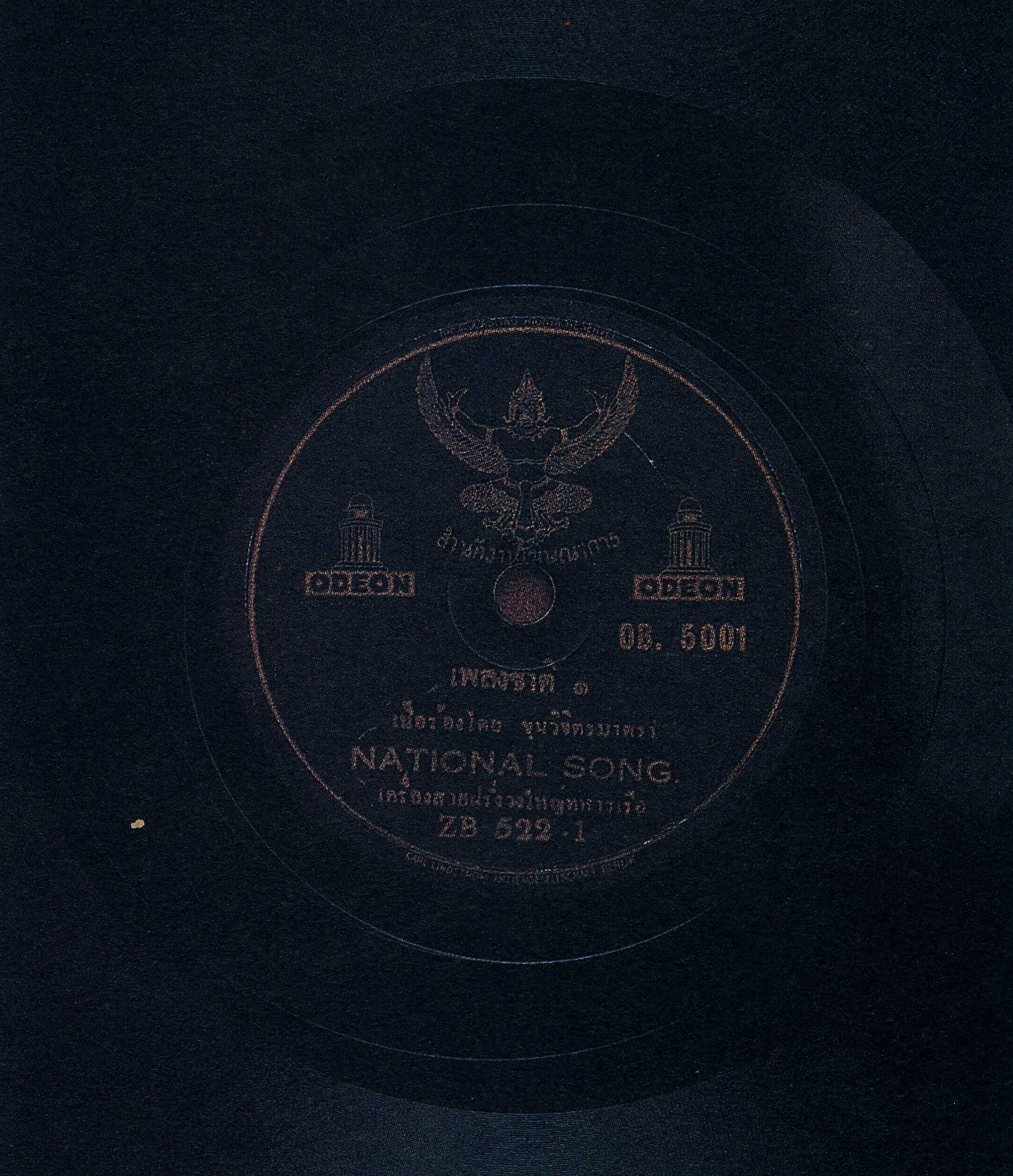
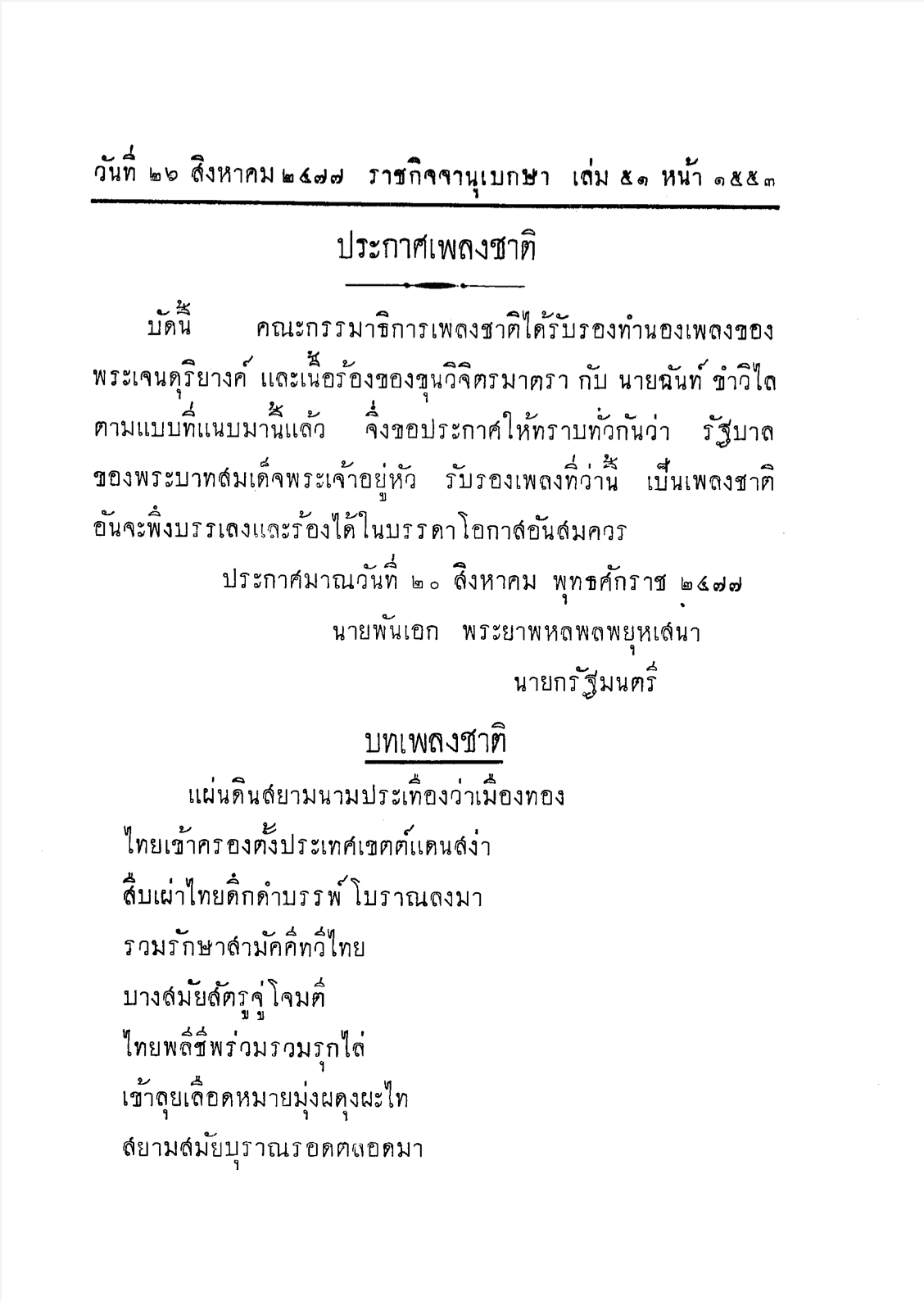
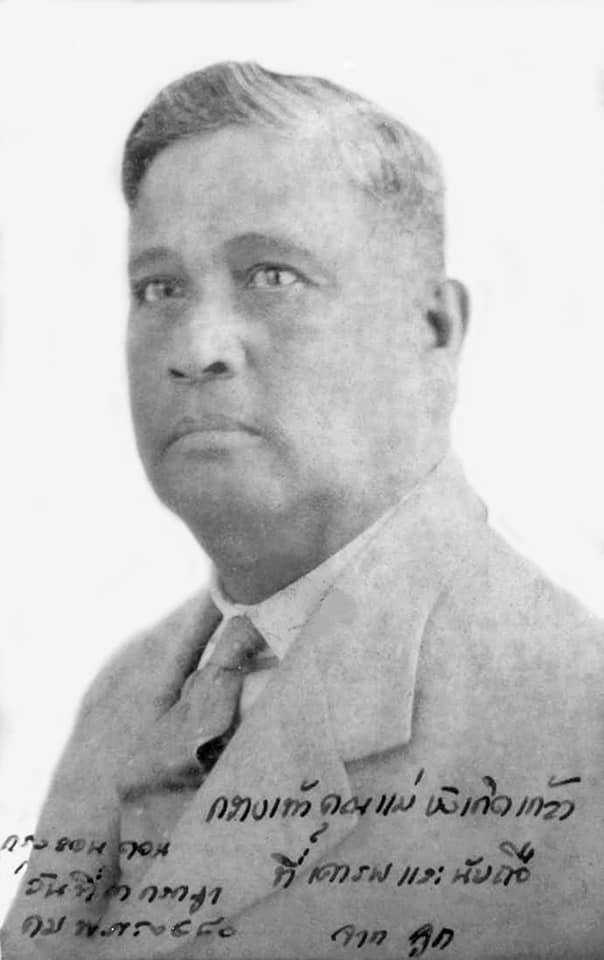
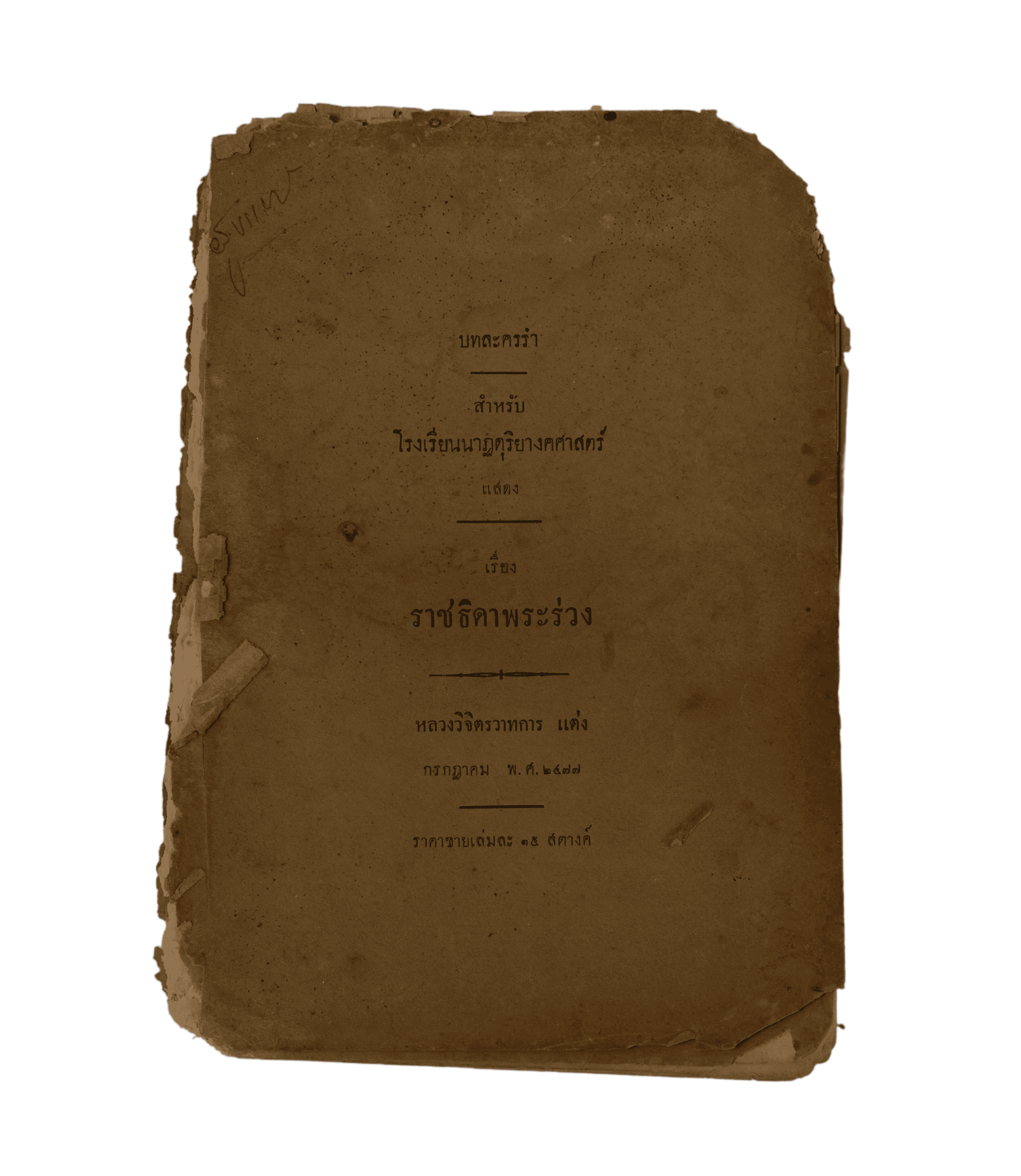
พ.ศ. 2475 ผู้ก่อการเปลี่ยนแปลงการปกครองให้ใช้เพลงชาติแทนเพลงสรรเสริญพระบารมี โดยมอบหมายให้พระเจนดุริยางค์ (ปิติ วาทยากร) เป็นผู้ประพันธ์ทำนอง และทำการบันทึกเสียงครั้งแรกโดยบริษัทโอเดียนเมื่อ พ.ศ. 2476 ลงแผ่นเสียงครั่ง บรรเลงด้วยวงเครื่องสายฝรั่งวงใหญ่ทหารเรือ หน้า 1 เป็นคำร้องของ ขุนวิจิตรมาตรา (สง่า กาญจนาคพันธุ์) และ หน้า 2 เป็นคำร้องของ นายฉันท์ ขำวิไล จัดทำโดย สำนักโฆษณาการ (ปัจจุบันคือ กรมประชาสัมพันธ์) ในเวลาต่อมามีการประกาศราชกิจจานุเบกษารับรองทำนองและเนื้อร้องเพลงชาติ เมื่อวันที่ 20 สิงหาคม 2477
พบหนังสือบทละครรำ สำหรับโรงเรียนนาฏดุริยางคศาสตร์ แสดงเรื่องราชธิดาพระร่วง หลวงวิจิตรวาทการ แต่ง กรกฎาคม พ.ศ. 2477 ราคาขายเล่มละ 15 สตางค์ อัษฎาวุธ สาคริก, การสื่อสารส่วนบุคคล, 4 กุมภาพั��นธ์ 2568)
In 1932, the leaders of the revolution that changed Thailand's government from a monarchy to a democracy decided the country should have a new national anthem. They chose Phra Chenduriyang (Piti Vathayakorn) to write the piece. The first recording was made in 1933 by the Odeon company. Performed by the western string orchestra and the orchestra of the navy. Side 1 of the record had lyrics by Khun Vichitra Matra (Sa-nga Kanchanakphan), and Side 2 had lyrics by Mr. Chan Khamwilai. The recording was produced by the Office of Public Relations (now the Public Relations Department). Later, on August 20, 1934, the Royal Gazette announced the official adoption of the melody and lyrics of the national anthem.
A book for the classical dance-drama Ratchathida Phra Ruang for the School of Dance and Music, written by Luang Wijit Ravatkan, published in July 1934 (B.E. 2477). The selling price was 15 satang per copy. (Asadawut Sakorik, personal communication, February 4, 2025)
Gallery
Bibliography
กลุ่มเผยแพร่ฯ กรมศิลปากร. https://www.facebook.com/photo.php?fbid=4115705728496840&id=280593928674725&set=a.4115705425163537&locale=th_TH, สืบค้นเมื่อ กุมภาพันธ์ 2568.
ธำมรงค์ บุญราช. เจ��้าดารารัศมี พระราชชายา : ฟ้อนม่านมุยเซียงตา. https://www.finearts.go.th/fad5/view/22624-%E0%B9%80%E0%B8%88%E0%B9%89%E0%B8%B2%E0%B8%94%E0%B8%B2%E0%B8%A3%E0%B8%B2%E0%B8%A3%E0%B8%B1%E0%B8%A8%E0%B8%A1%E0%B8%B5-%E0%B8%9E%E0%B8%A3%E0%B8%B0%E0%B8%A3%E0%B8%B2%E0%B8%8A%E0%B8%8A%E0%B8%B2%E0%B8%A2%E0%B8%B2---%E0%B8%9F%E0%B9%89%E0%B8%AD%E0%B8%99%E0%B8%A1%E0%B9%88%E0%B8%B2%E0%B8%99%E0%B8%A1%E0%B8%B8%E0%B8%A2%E0%B9%80%E0%B8%8B%E0%B8%B5%E0%B8%A2%E0%B8%87%E0%B8%95%E0%B8%B2 และบทแผ่นเสียงของราชบัณฑิตยสภา. ชุดที่ 1. (2517). กรุงเทพ: โรงพิมพ์พระจันทร์.
พูนพิศ อมาตยกุล. (2526). คณะนารีศรีสุมิตร วงเครื่องสายผสมเปียนโนหญิง วงแรกของประเทศไทย. อนุสรณ์ในงานเสด็จพระราชดำเนินพระราชทานเพลิงศพ พระสุจริตสุดา (เปรื่อง สุจริตกุล) ท.จ.ว. พระสนมเอกในรัชกาลที่ 6 (29 มีนาคม หน้า 24-27). ม.ป.ท.: ม.ป.พ.
พูนพิศ อมาตยกุล. (2540). ลำนำแห่งสยาม. กรุงเทพฯ: บริษัท อมรินทร์พริ้นติ้ง แอนด์ พับลิชชิ่ง จำกัด.
พฤฒิพล ประชุมพล. (ม.ป.ป.). เครื่องเสียงโบราณ ตำนานแห่งศาสตร์และศิลป์. กรุงเทพฯ: สมาคมนักอนุรักษ์เครื่องเล่นกระบอกเสียงและหีบเสียง.
ภาพพระเจนดุริยางค์ (ปิติ วาทยากร) ผู้ประพันธ์ทำนองเพลงชาติไทย. https://www.facebook.com/photo/?fbid=276651037799198&set=pcb.276651301132505&locale=th_TH, สืบค้นเมื่อ กุมภาพันธ์ 2568.
มนตรี ตราโมท, 2443-2538 และ วิเชียร กุลตัณฑ์, 2457-2526 (2523). ฟังและเข้าใจเพลงไทย. โรงพิมพ์ไทยเขษม.
เมื่อเดือนคล้อย เรือโท มานิต เสณะวีณิน ขับร้อง / เครื่องสายฝรั่ง วงมานิตแจ๊ส https://www.youtube.com/watch?v=Gsv43MOPqp4. สืบค้นเมื่อ กุมภาพันธ์ 2568.
สำนักหอจดหมายเหตุแห่งชาติ ก . (2476). ศธ.0701.7/147 เรื่อง บริษัทฮัมเบิกสยามส่งแผ่นเสียงมาให้ ลงวันที่ 14 เมษายน พ.ศ. 2476.
_____ ข . (2476). สบ.2.31/23 เรื่อง แผ่นเสียงราชบัณฑิตยสภา ลงวันที่ 13 เมษายน พ.ศ. 2476. หอสมุดแห่งชาติ. (ม.ป.ป.). แผ่นเสียงในสยาม.
อนุสรณ์ในงานเสด็จพระราชดำเนินพระราชทานเพลิงศพ พระสุจริตสุดา (เปรื่อง สุจริตกุล) ท.จ.ว. พระสนมเอกในรัชกาลที่ 6 (29 มีนาคม หน้า 24-27). ม.ป.ท.: ม.ป.พ.
คณะผู้จัดทำ Exhibition Working Group
ที่ปรึกษาด้านการจัดทำนิทรรศการ (Exhibition Organization Advisors)
- 1. ผู้ช่วยศาสตราจารย์ ดร.สราวุธ เวชกิจ (Asst. Prof. Sarawoot Watechagit, Ph.D.)
- 2. อาจารย์ ดร.เอกชัย วารินศิริรักษ์ (Lect. Dr. Eakkachai Warinsiriruk)
- 3. นางสายชล จันทร์เพชร (Mrs. Saichol Chanpet)
- 4. นางสาวเพชรดา ฐิติยาภรณ์ (Ms. Petchrada Thitiyaporn)
- 5. นายพงศกร ระวิเพียรทรัพย์ (Mr. Pongsakorn Ravipiansub)
ที่ปรึกษาด้านเนื้อหานิทรรศการ (Exhibition Content Advisors)
- 1. ศาสตราจารย์เกียรติคุณ นพ.พูนพิศ อมาตยกุล (Prof. Emeritus Poonpit Amatyakul, M.D.)
- 2. คุณทวีสิงห์ ฆังนิมิตร (Mr. Taweesingh Kungnimitr)
- 3. อาจารย์อัษฎาวุธ สาคริก (Lect. Asadawut Sagarik)
- 4. คุณศิขิน พงษ์พิพัฒน์ (Mr. Sikin Pongpipat)
เรียบเรียงข้อมูล (Content Organization Team)
- 1.นางสาวณัฐิดา นุ่มปราณี (Ms. Nuttida Numpranee)
- 2. นางสาวภัทริกา นันทวิชิต (Ms. Pattharika Nanthawichit)
แปล (Thai to English Translation Team)
- 1. นายปรเมศวร์ รังษีสุริยันต์ (Mr. Poramate Rangsrisuriyant)
- 2. นางสาวแก้วกาญจน์ ถิ่นหัวเตย (Ms. Keawkarn Tinhuatoey)
- 3. นายวีษุวัต ศรีวรพจน์ (Mr. Visuvat Srivorapot)
ออกแบบ-ศิลปกรรม (Exhibition Art and Design Team)
- 1. นายคมสันต์ เดือนฉาย (Mr. Khomsan Duanchai)
- 2. นายอานนท์ ปุ้ยตระกูล (Mr. Arnon Puitrakul)